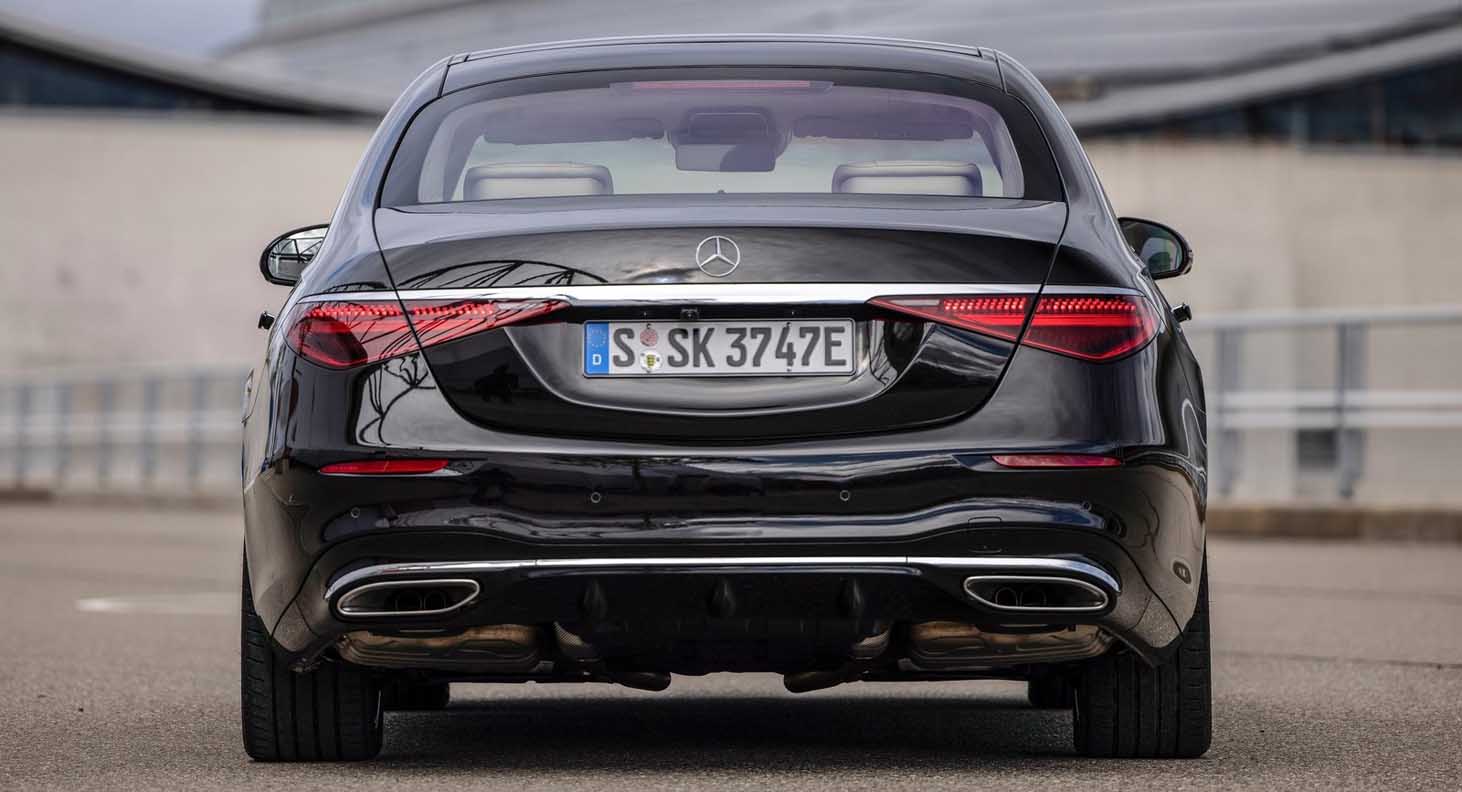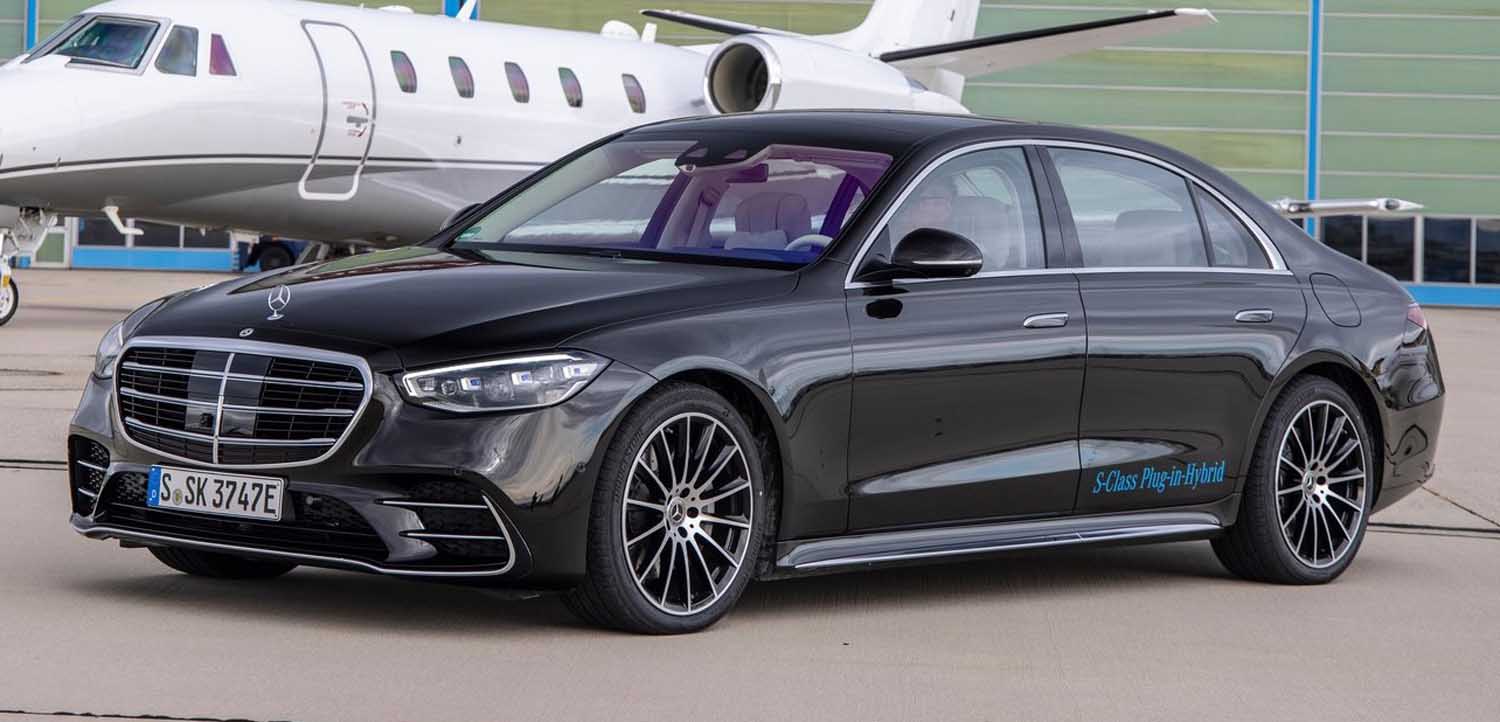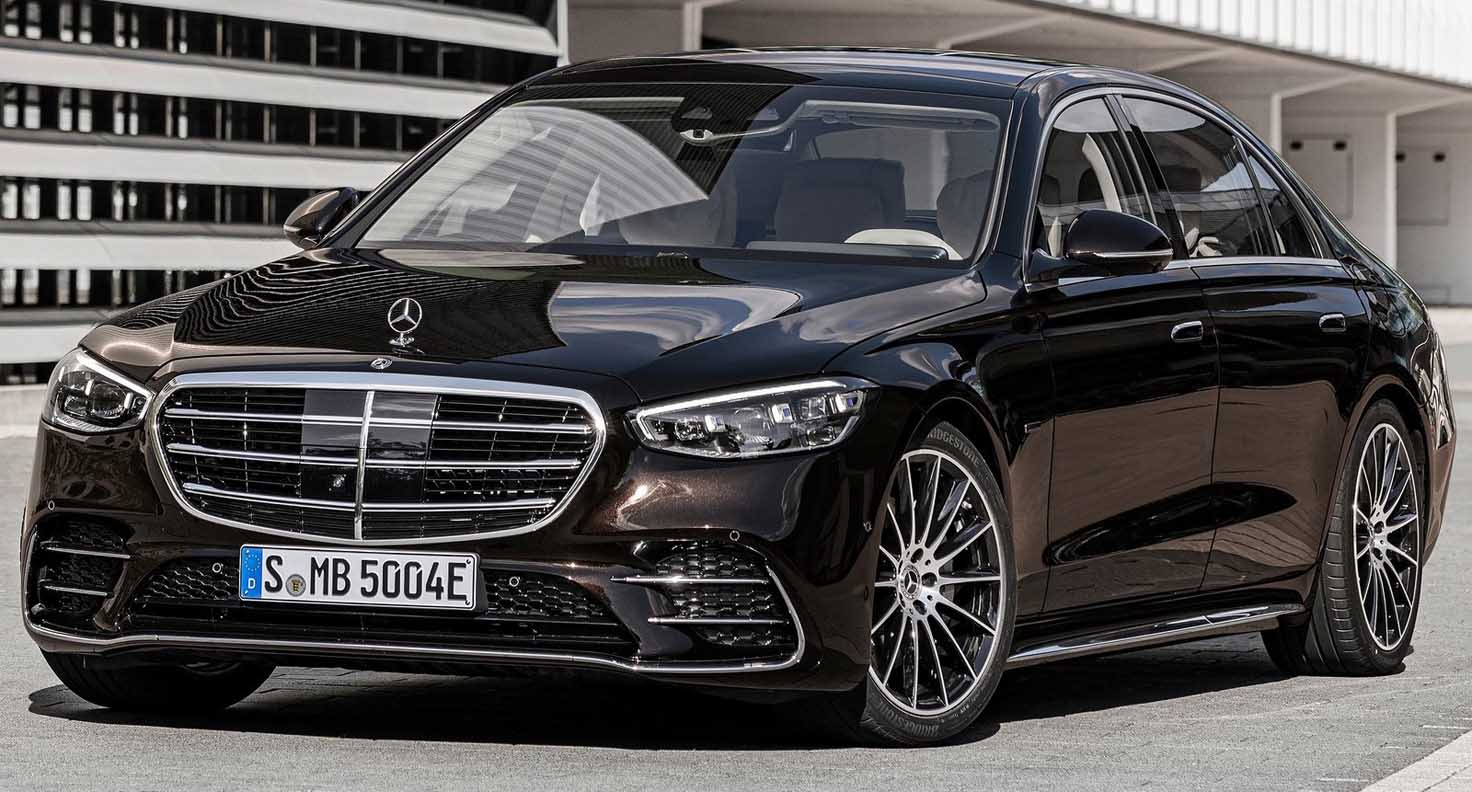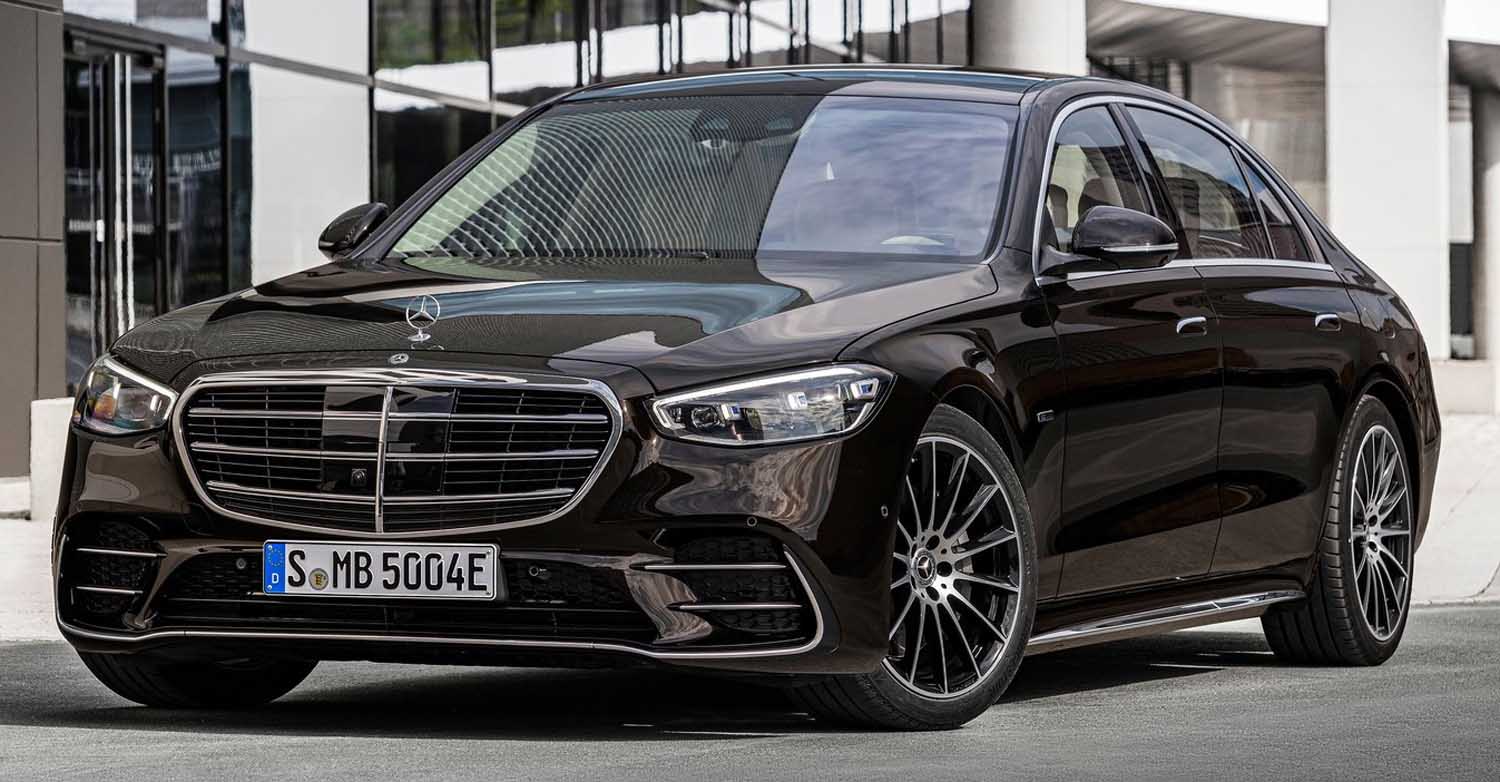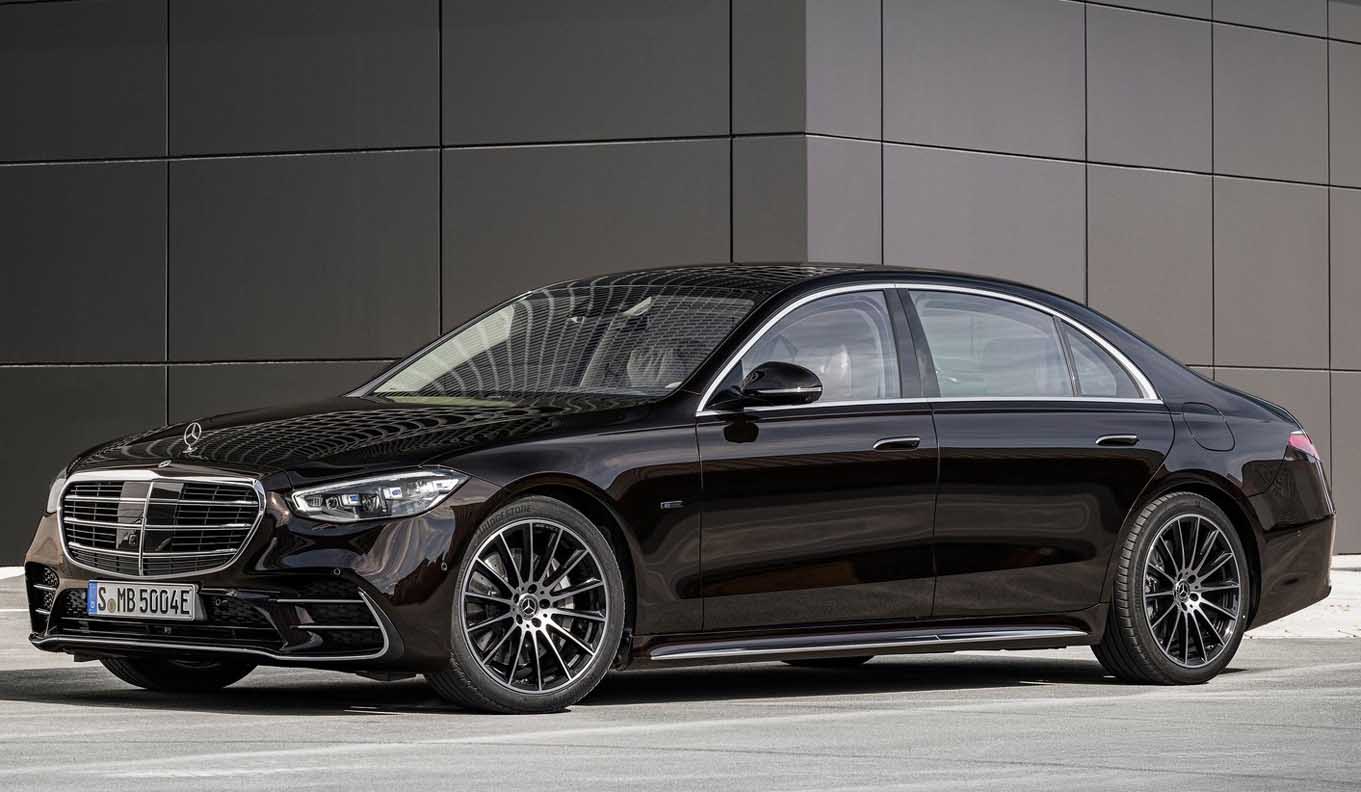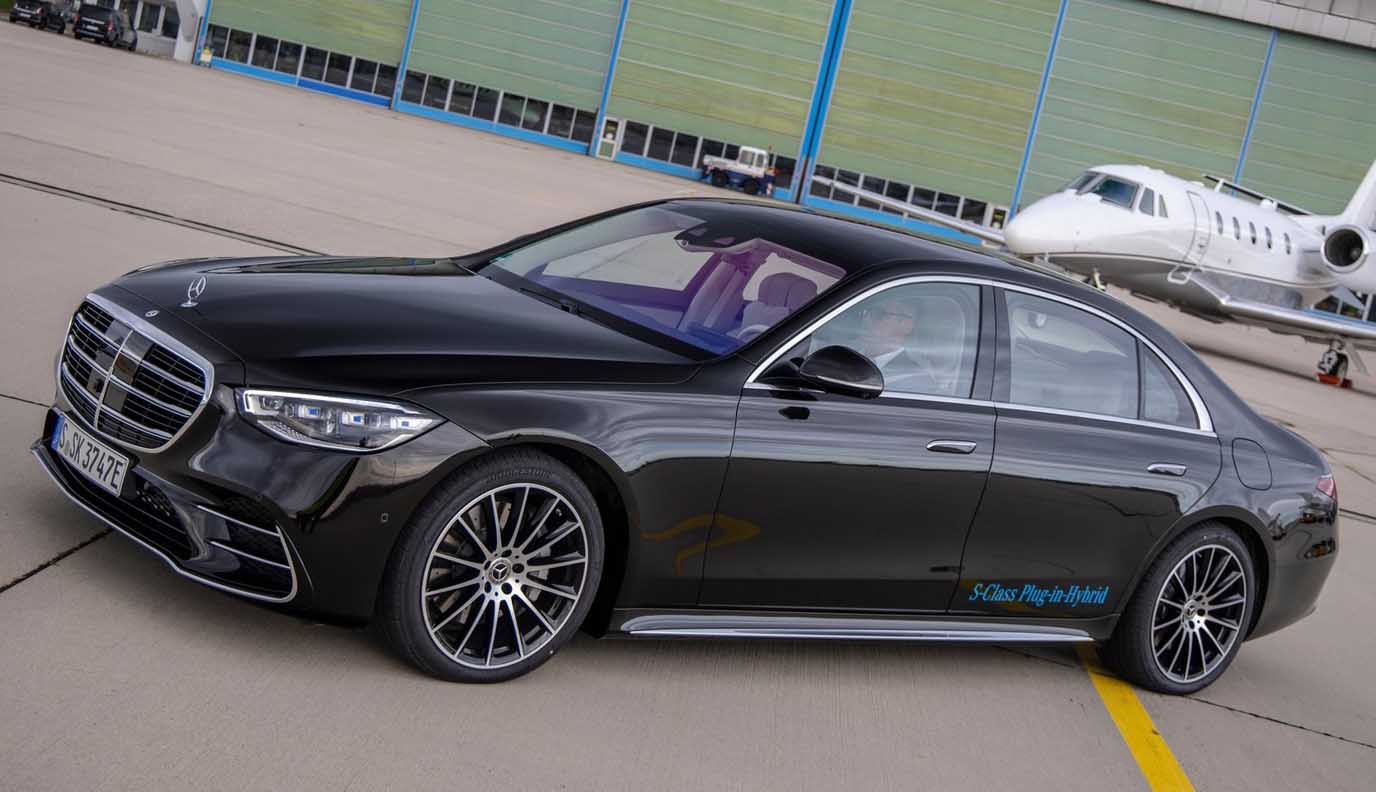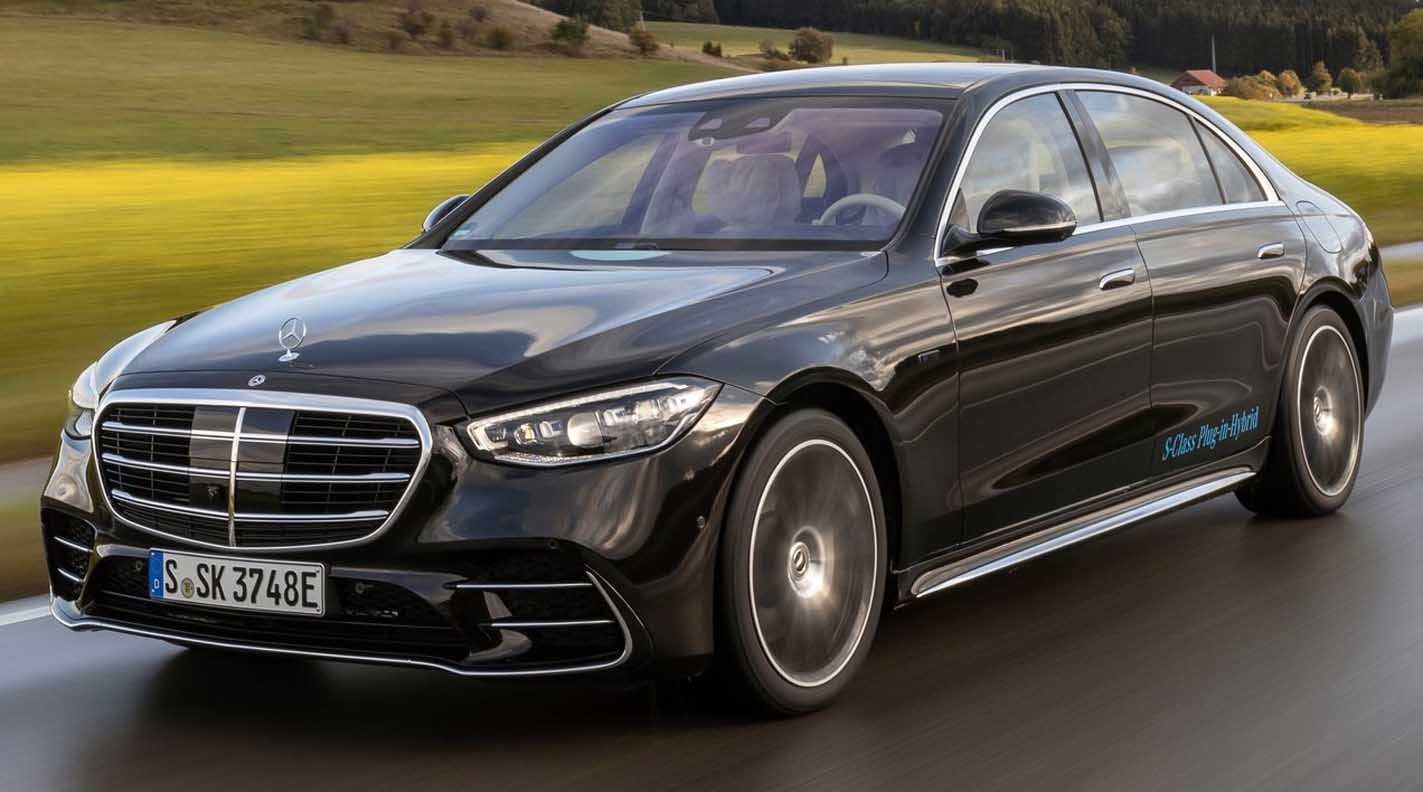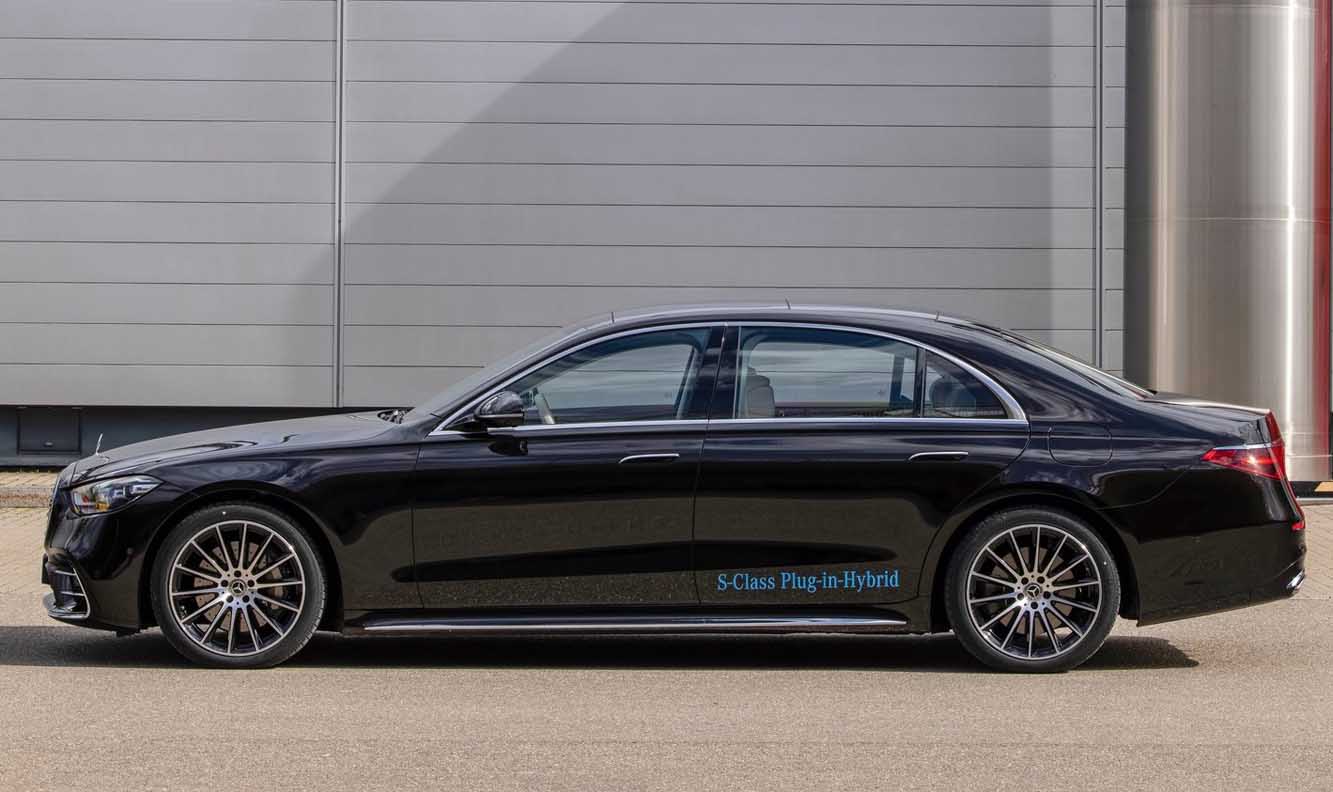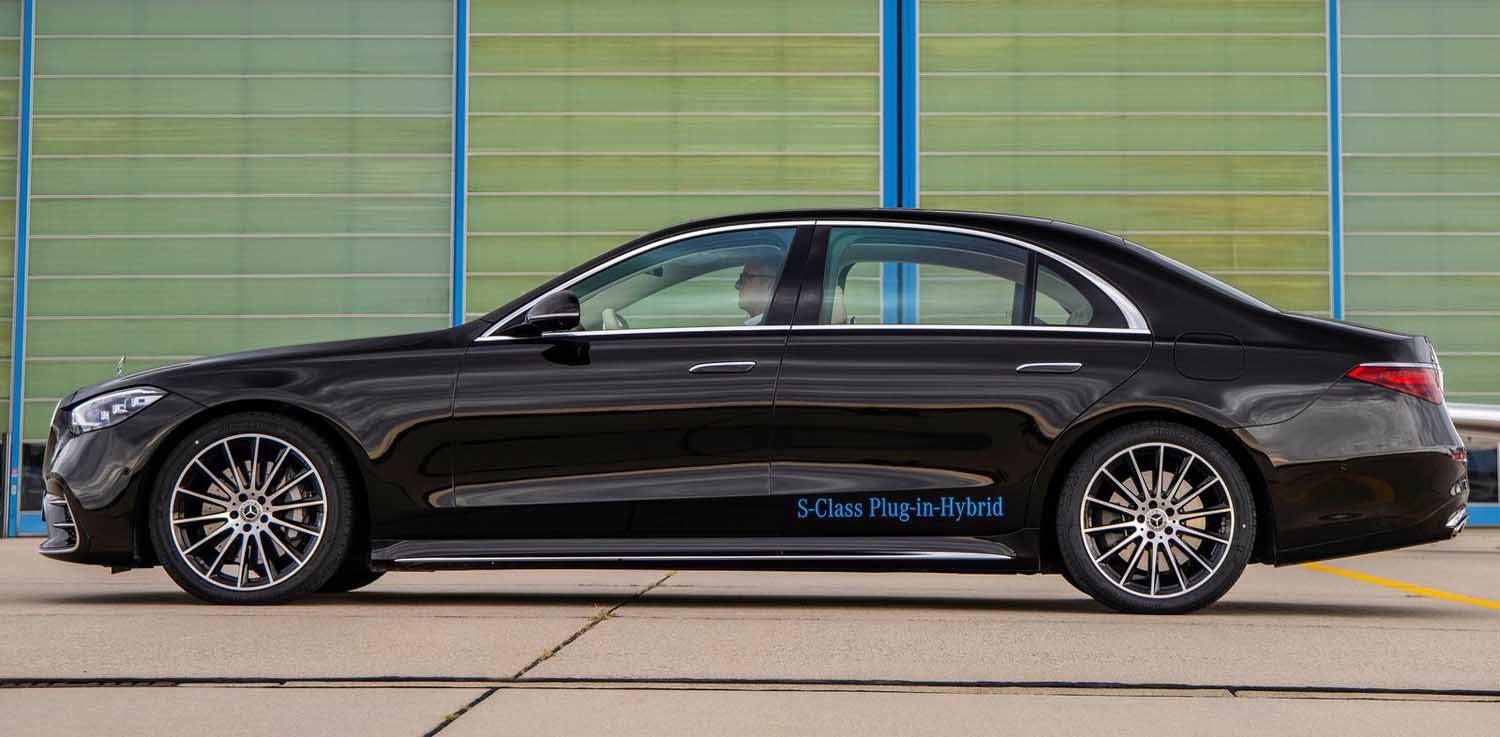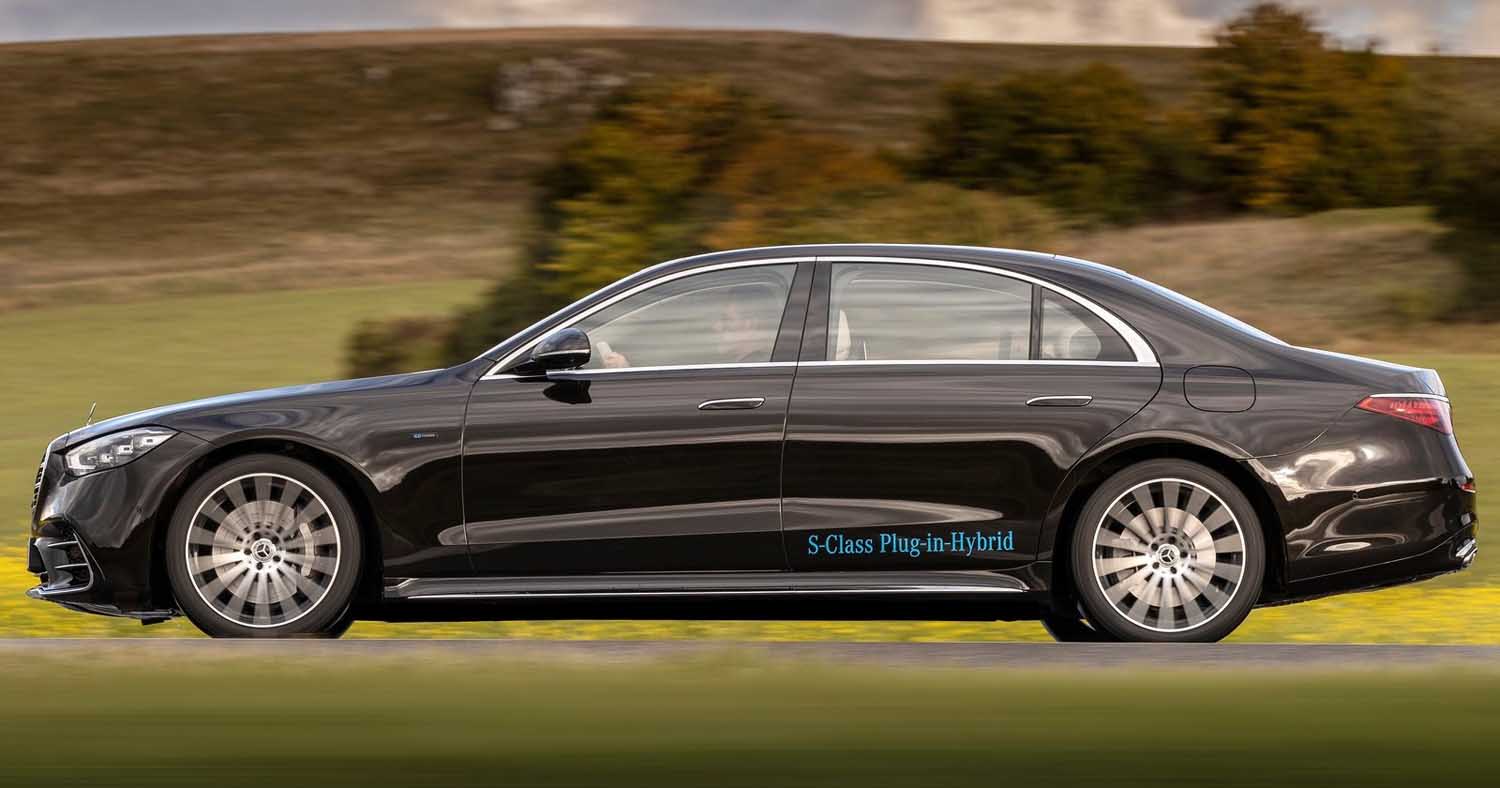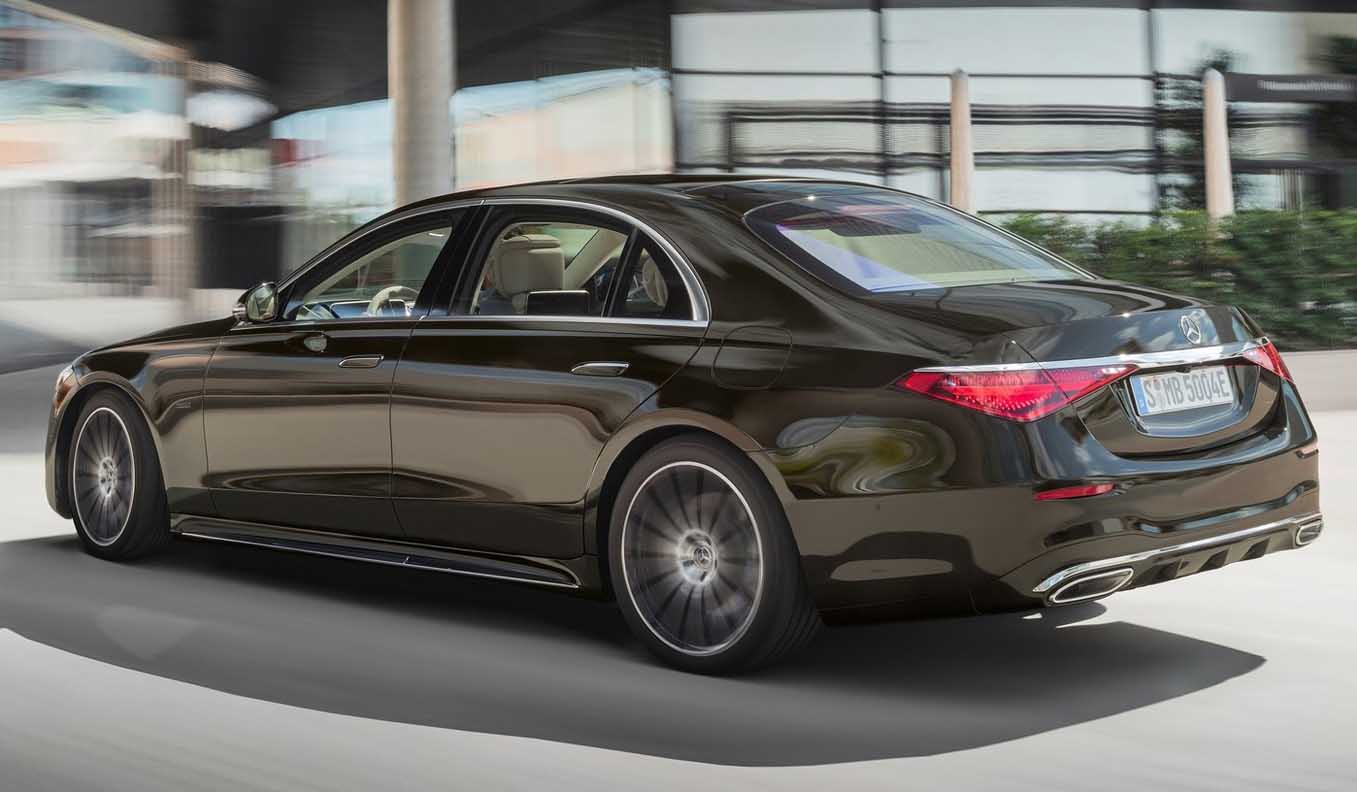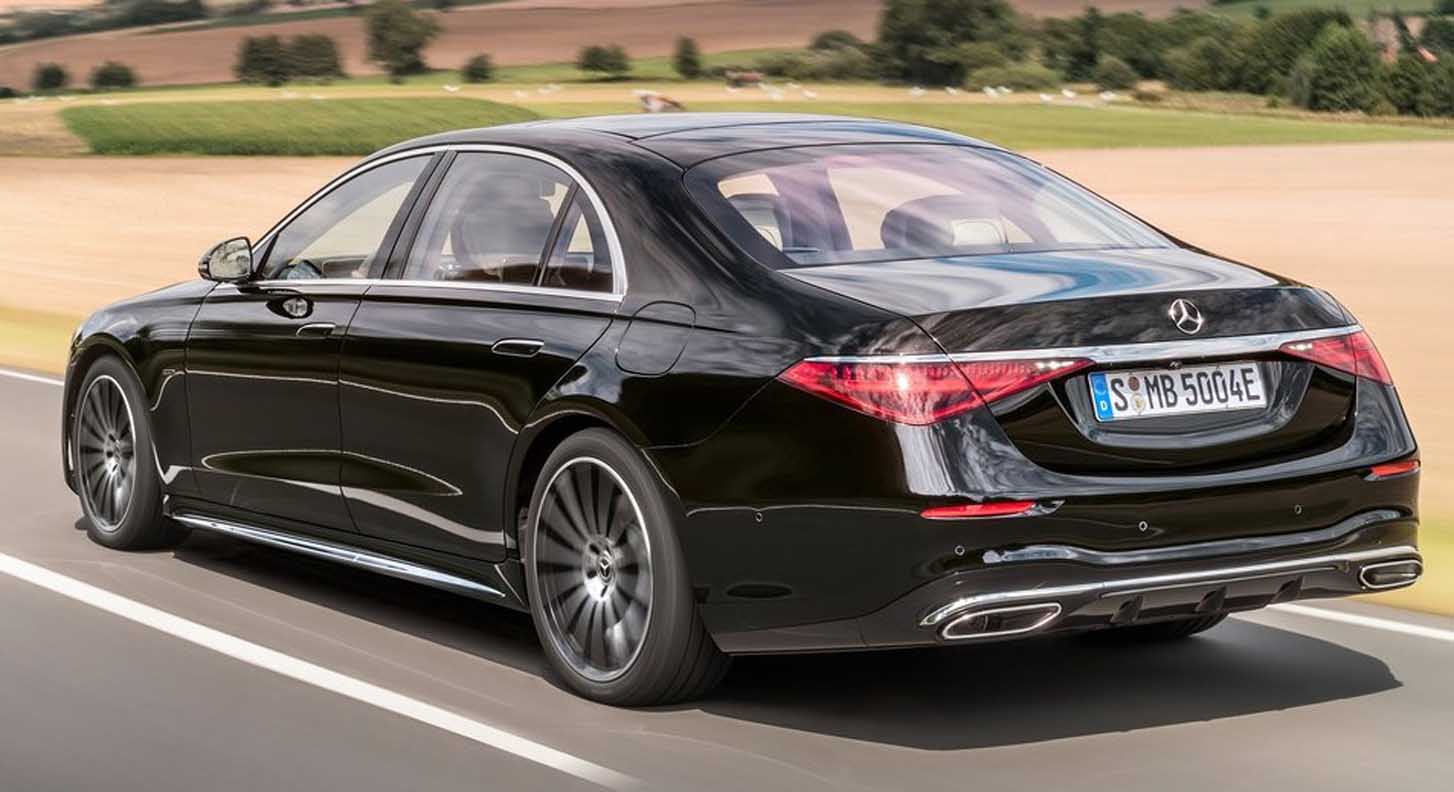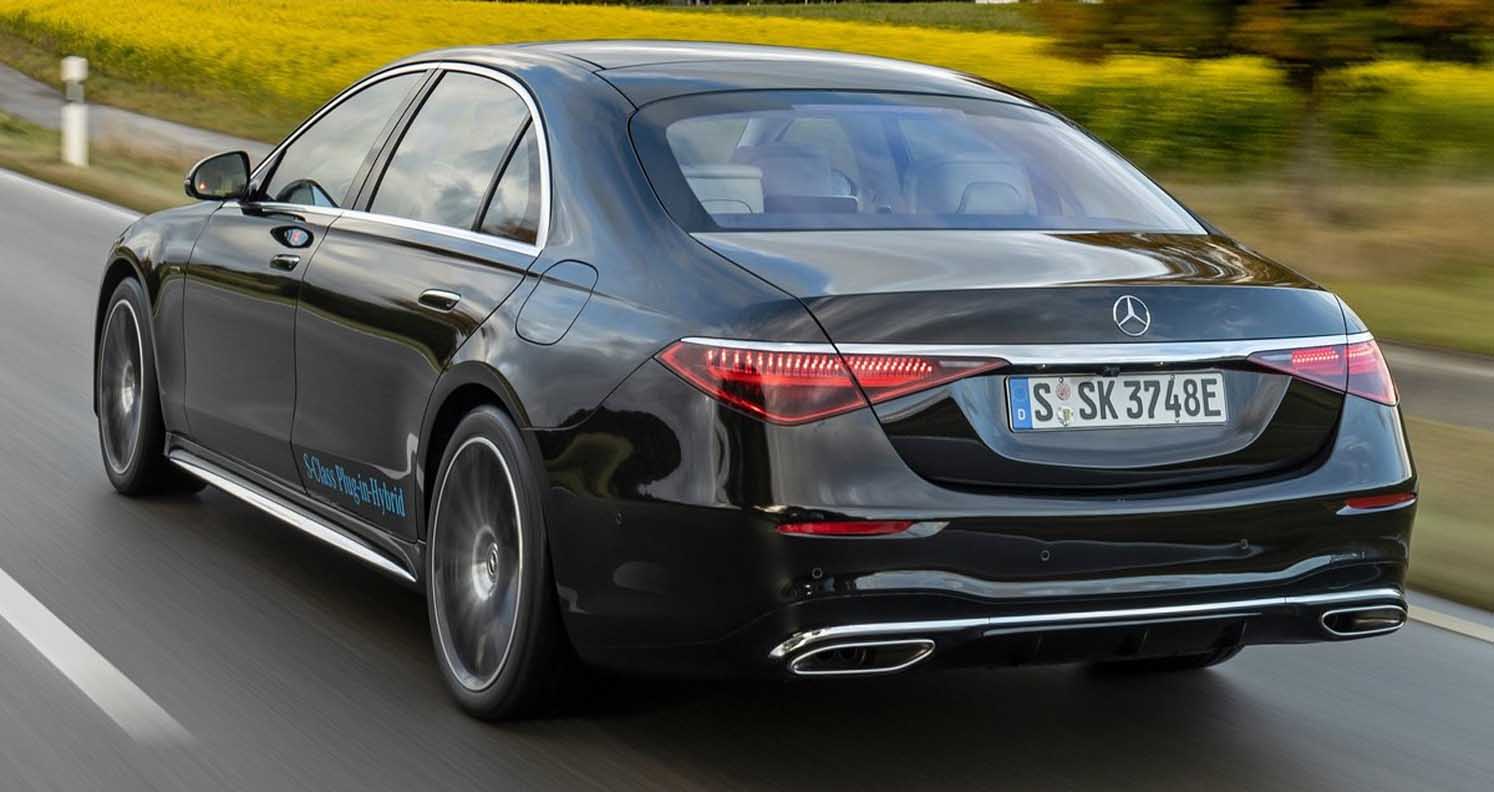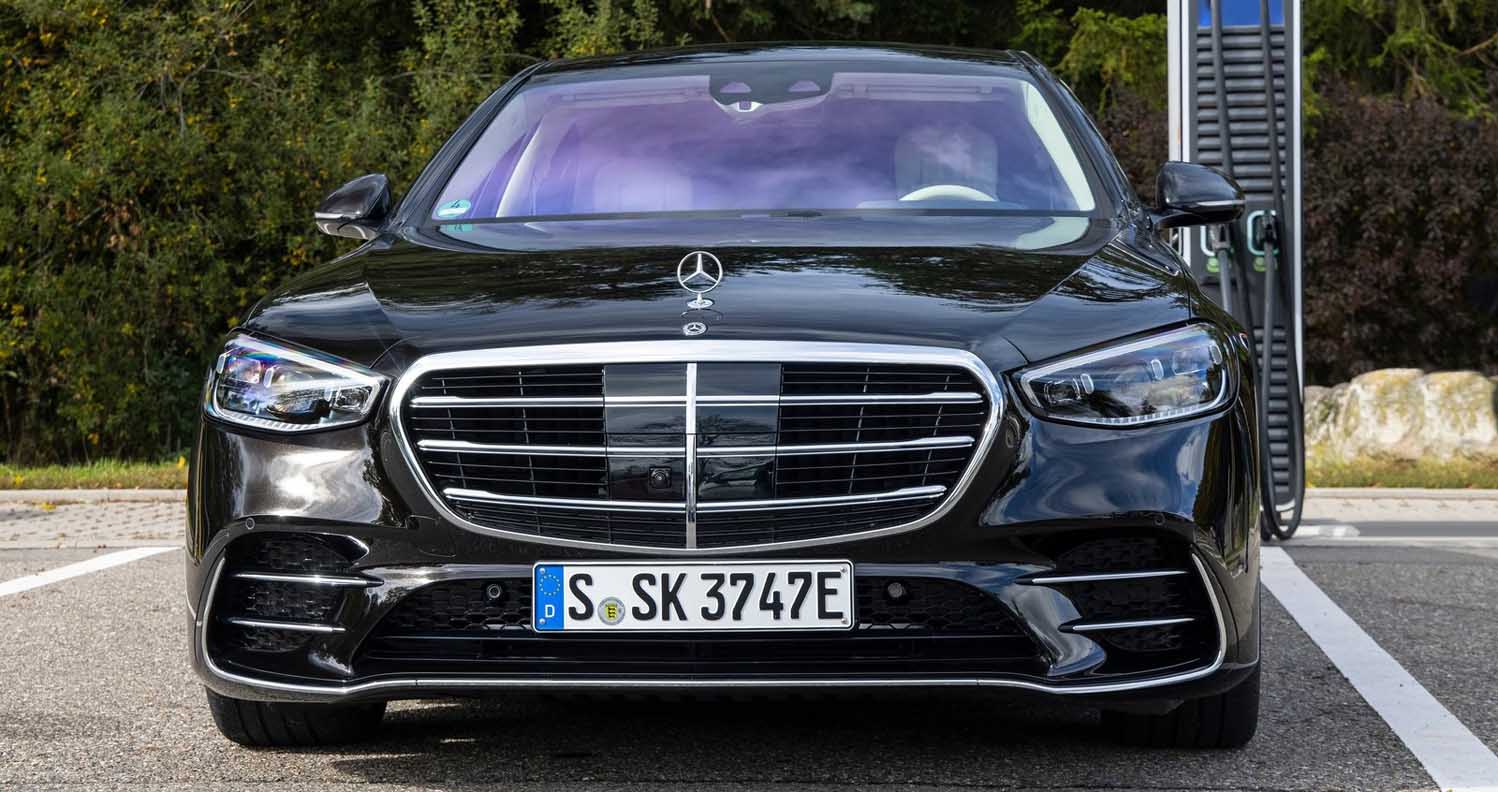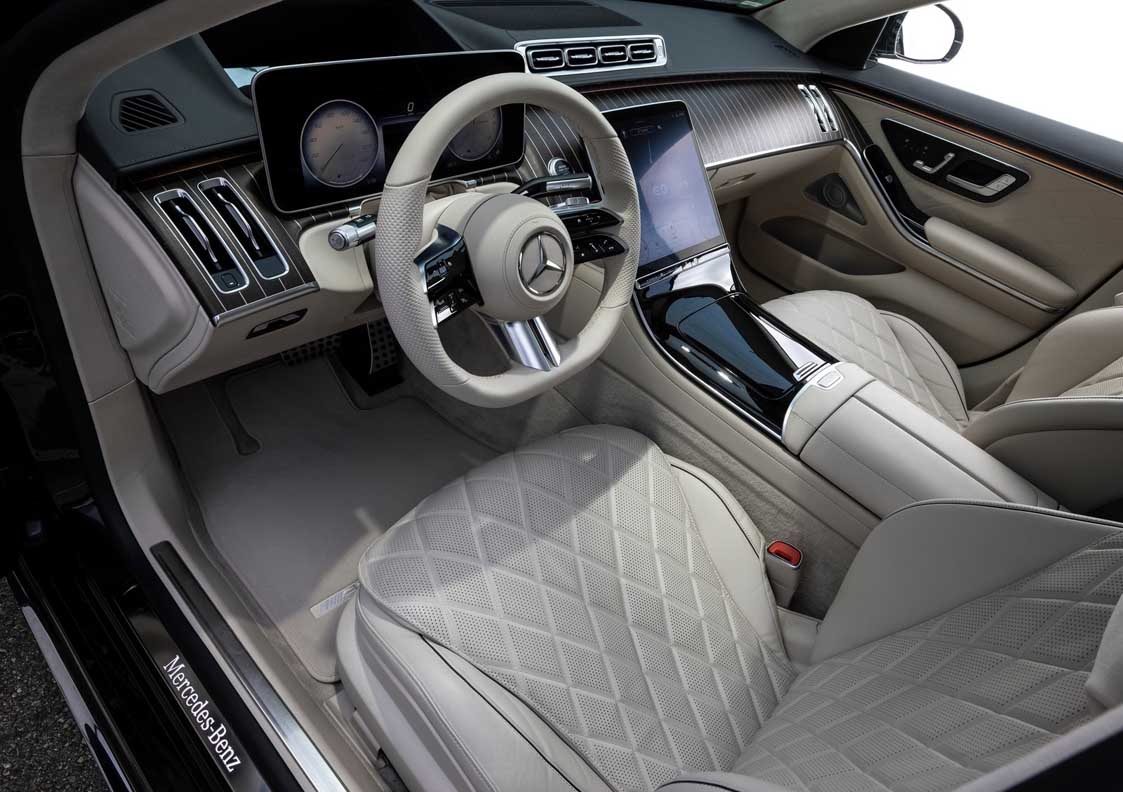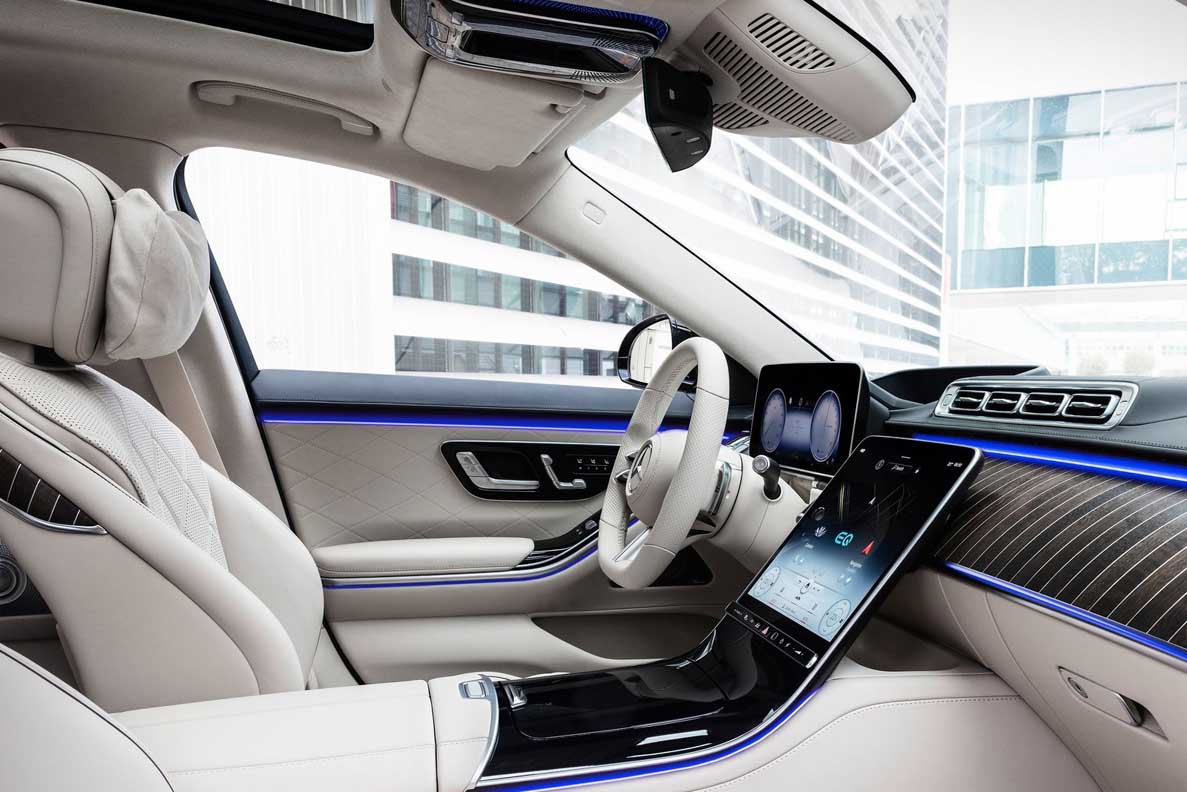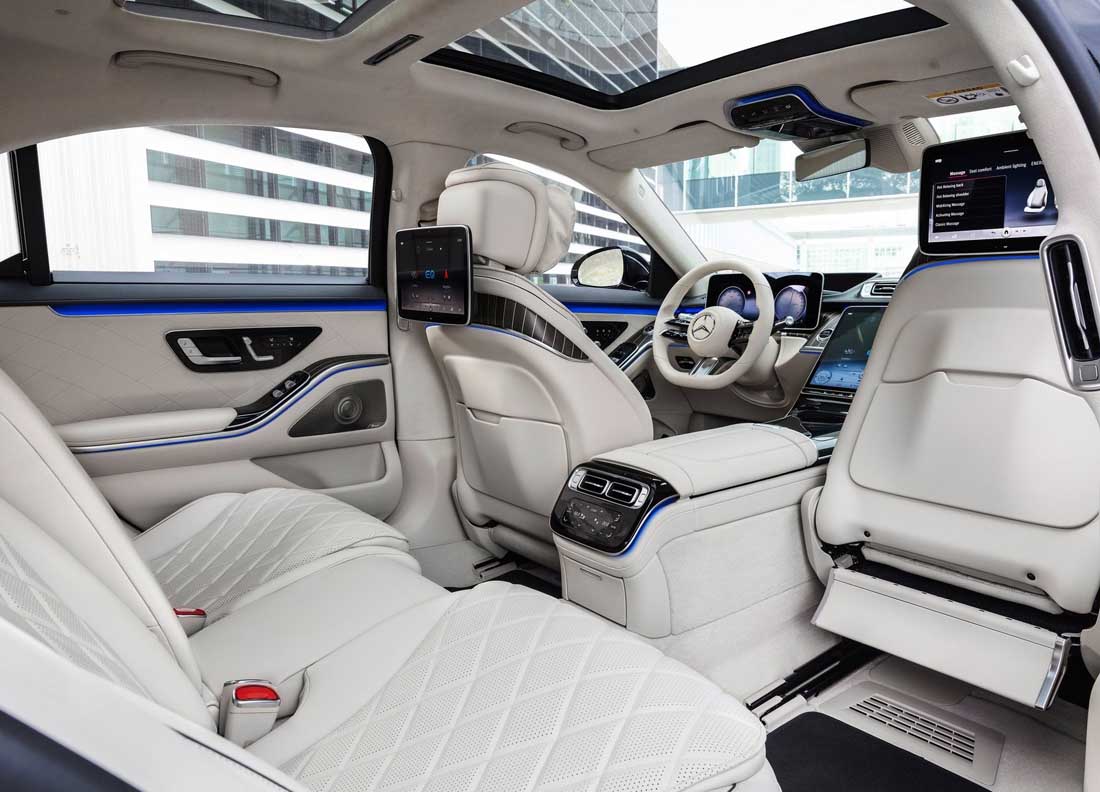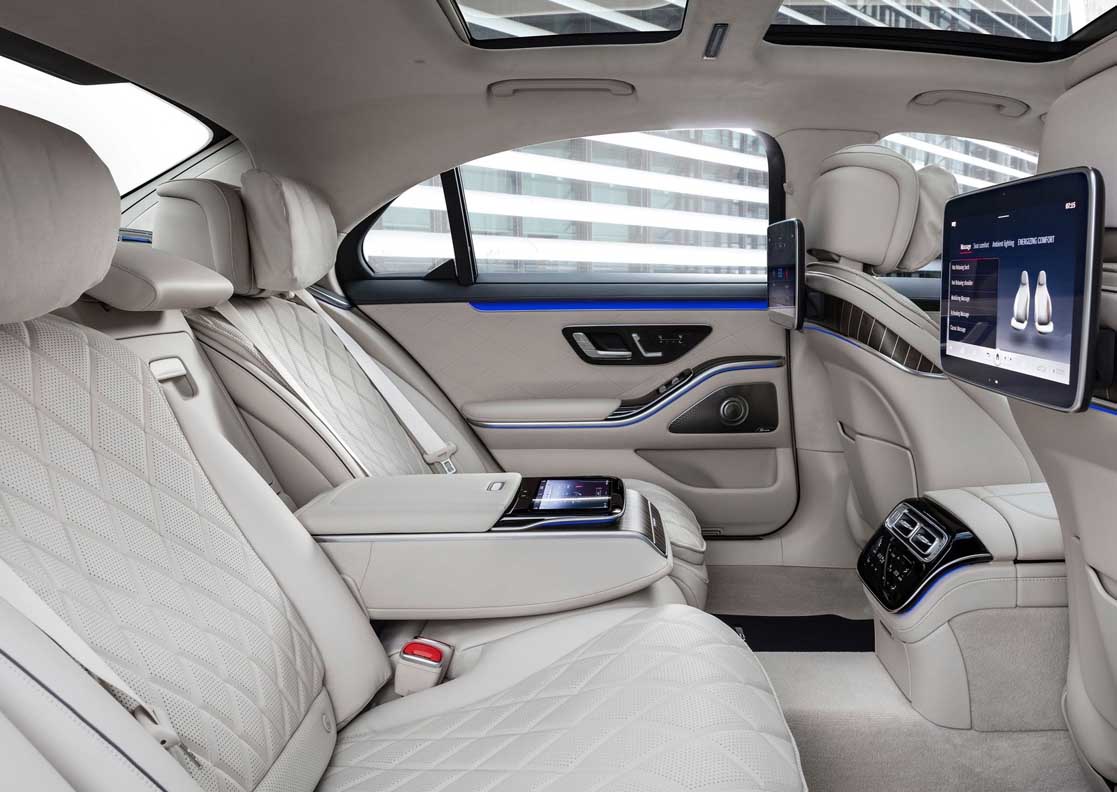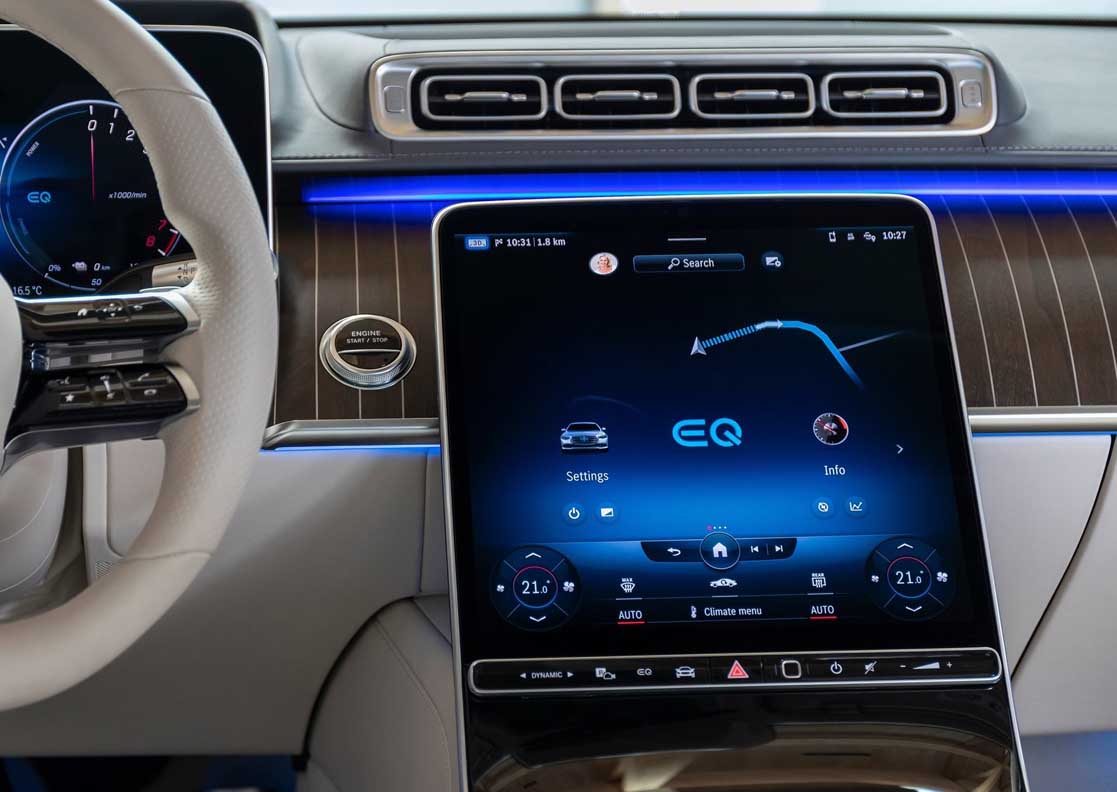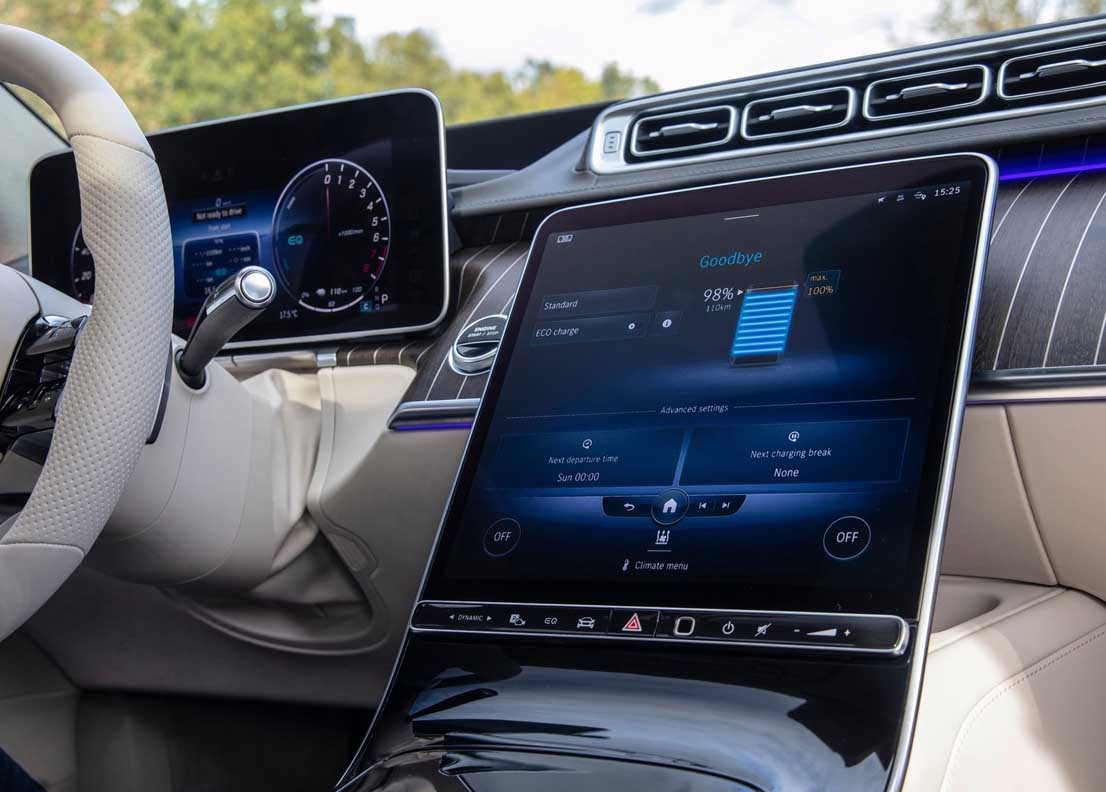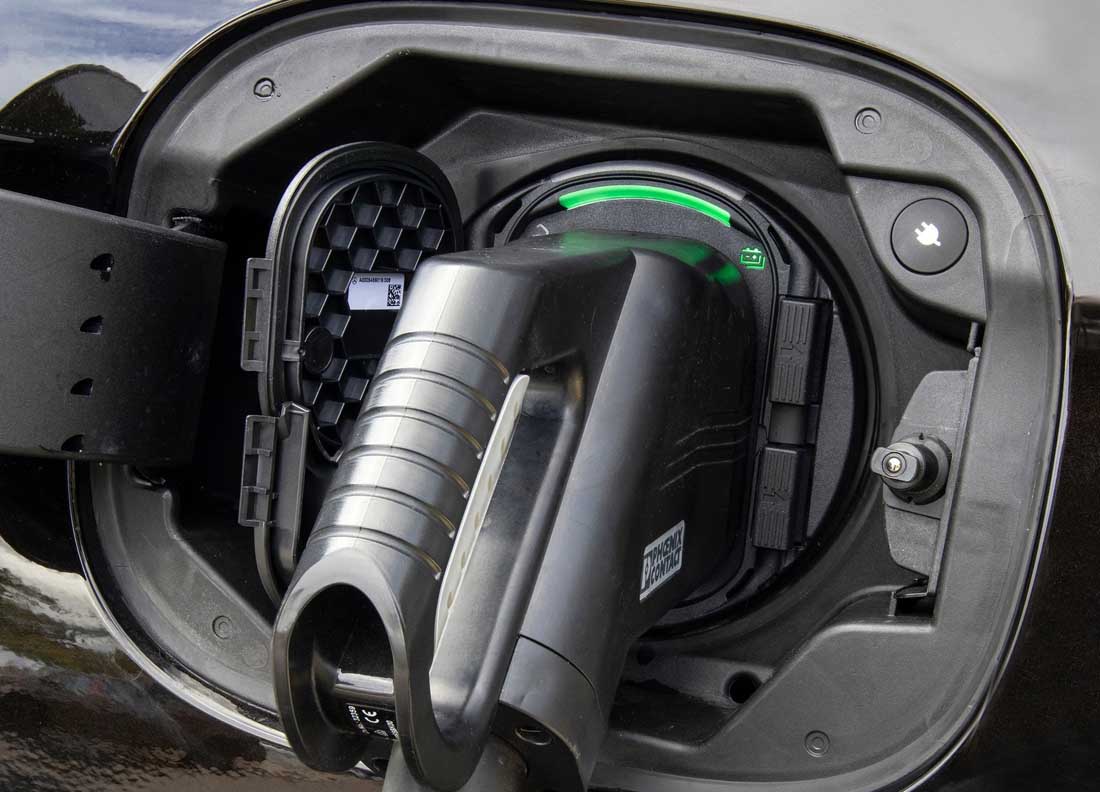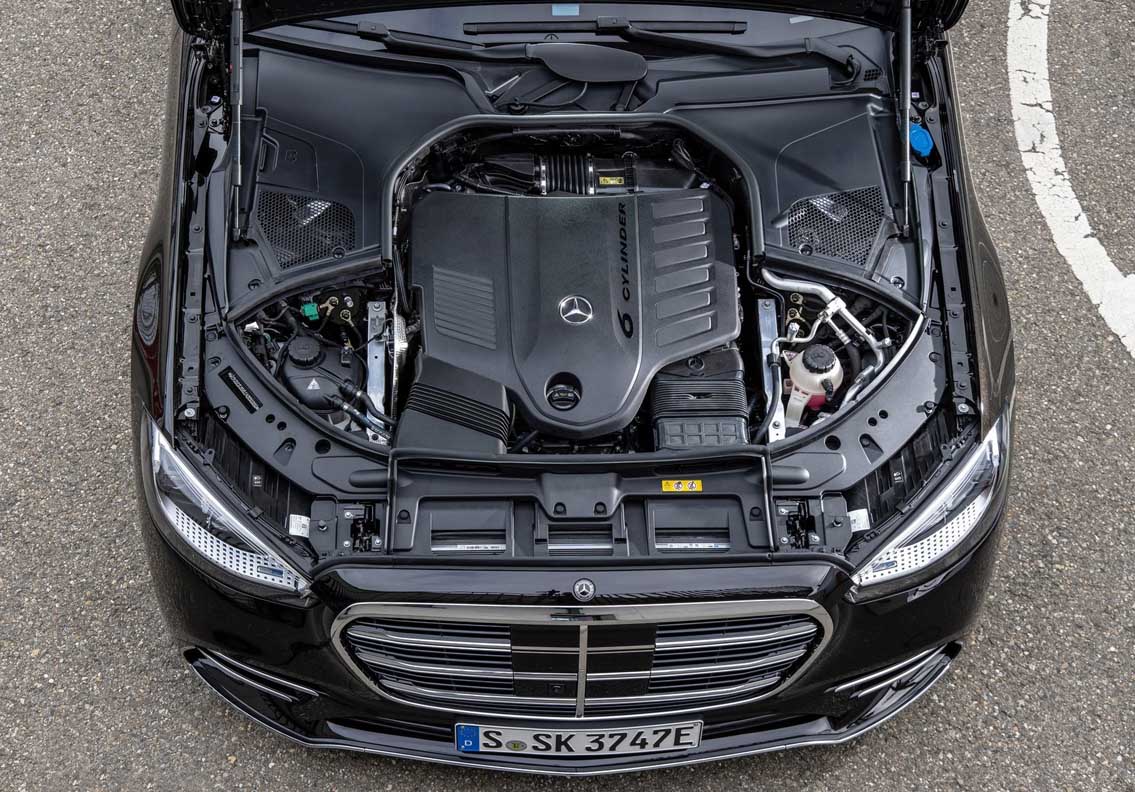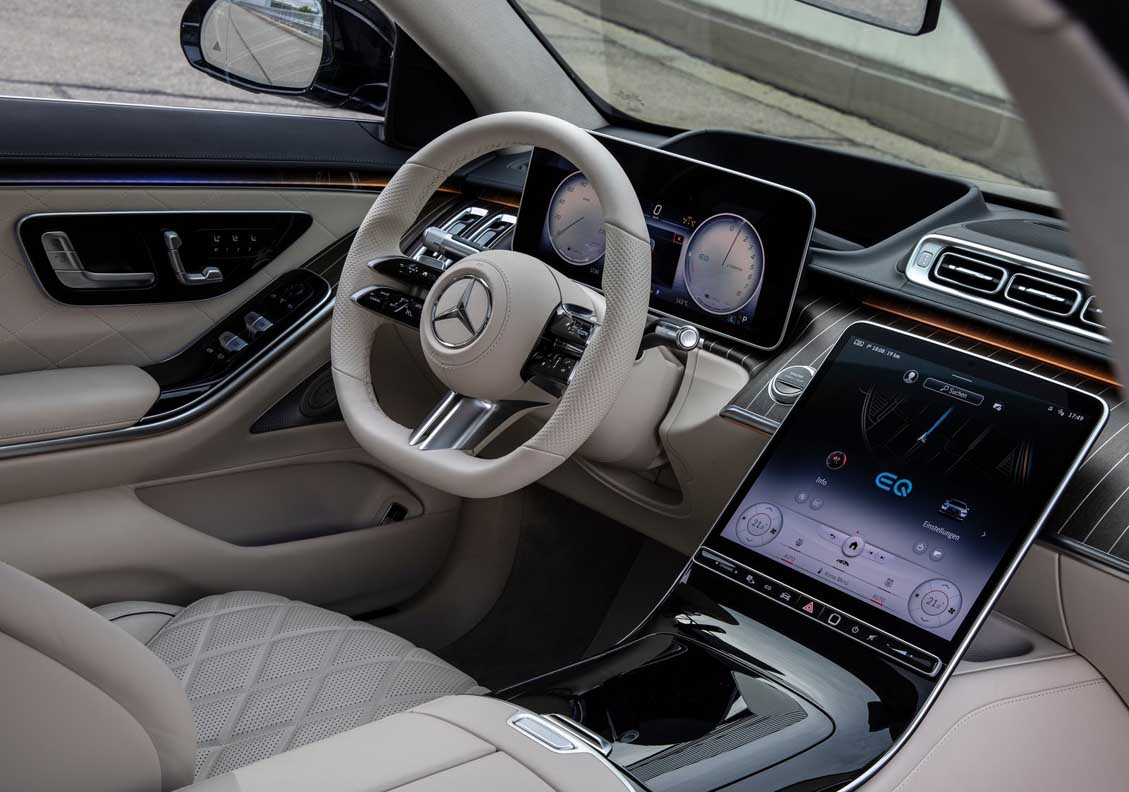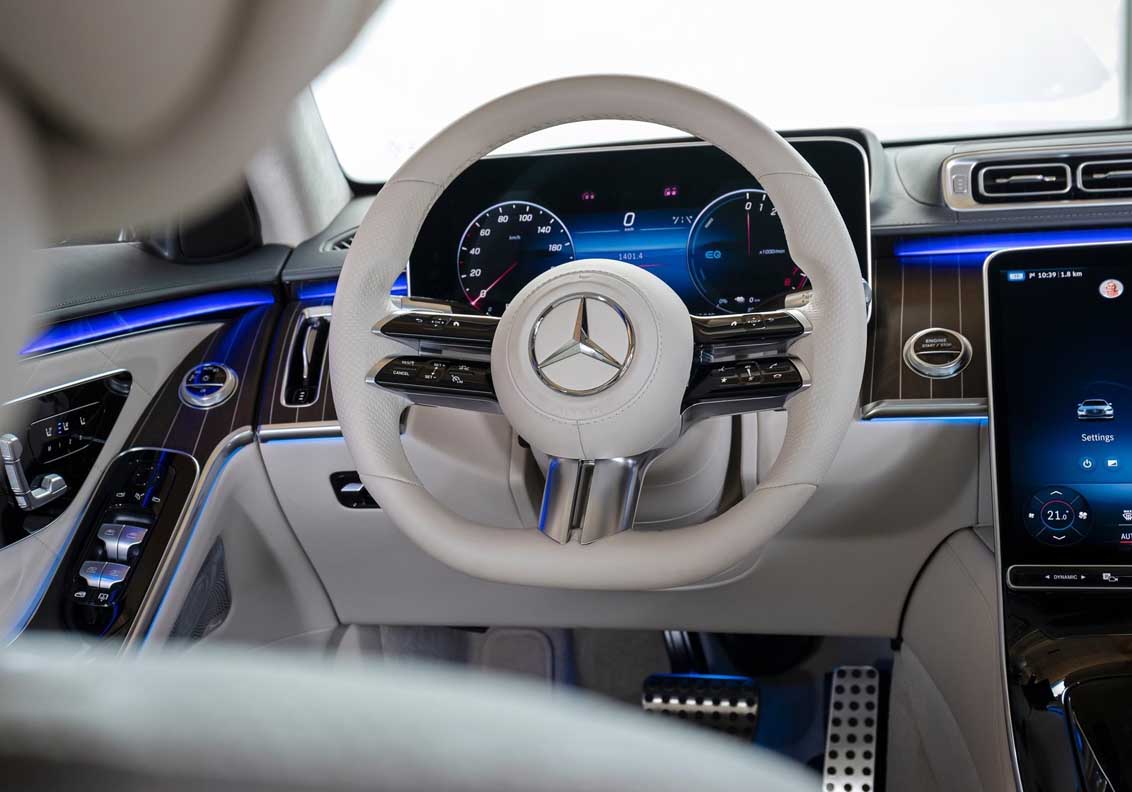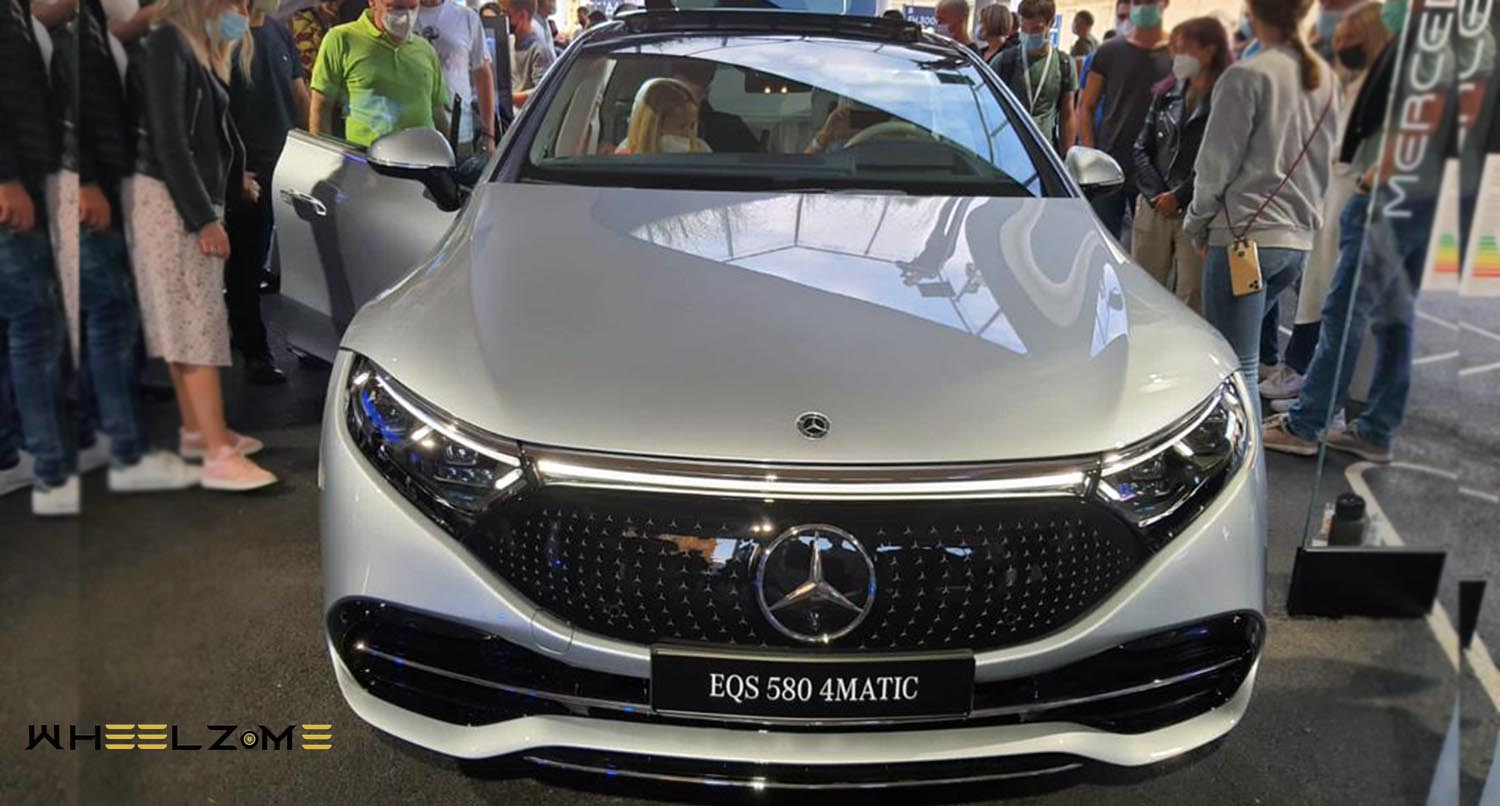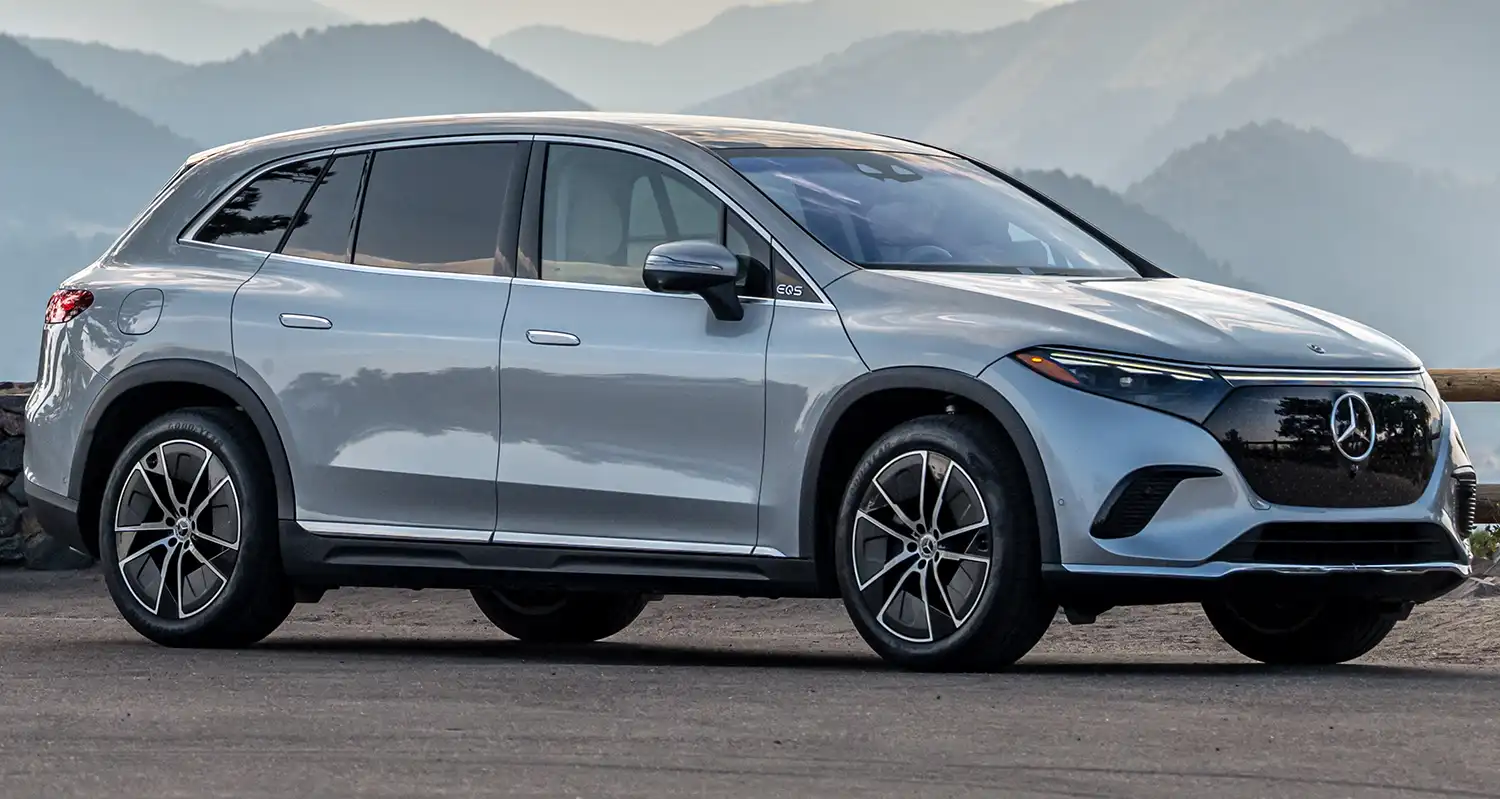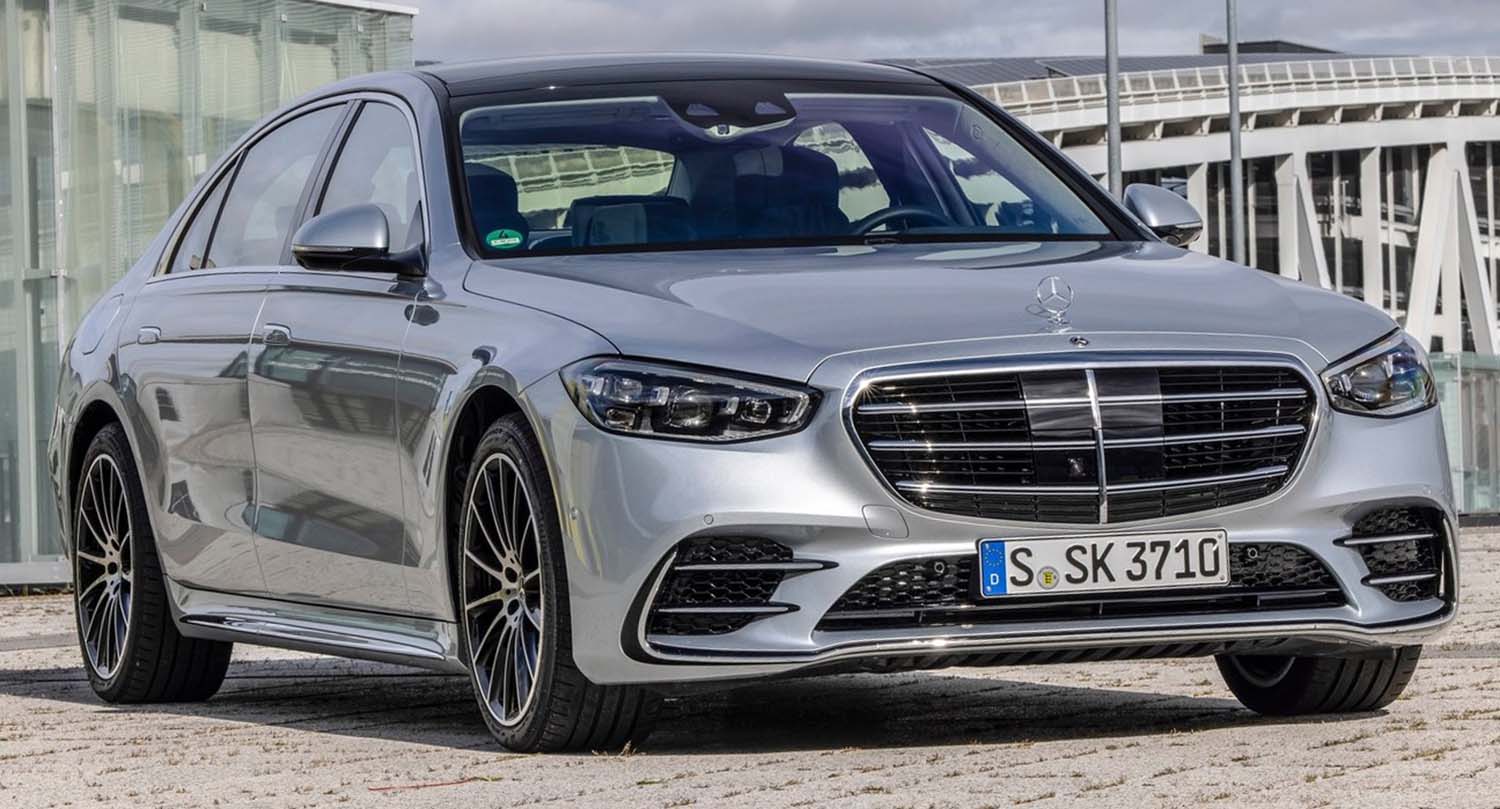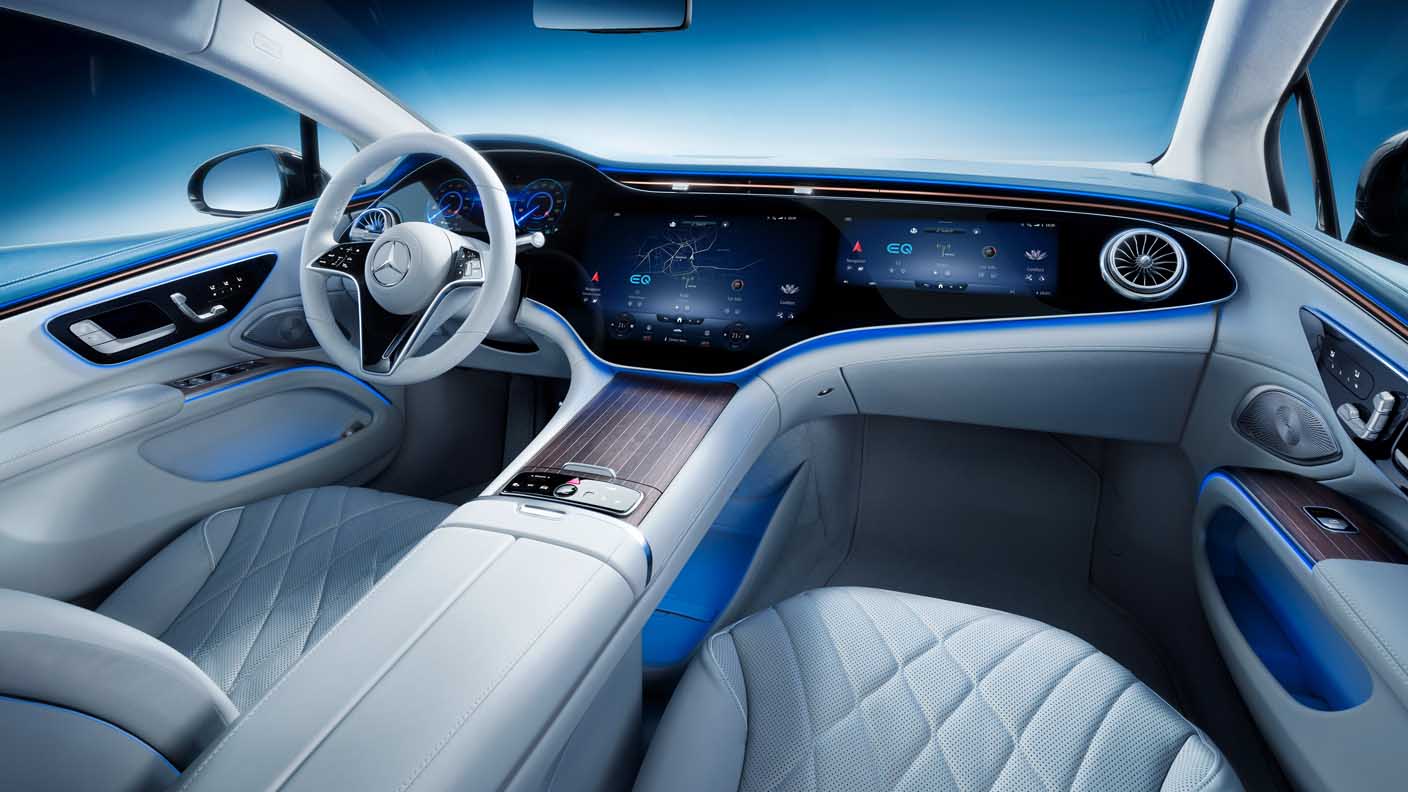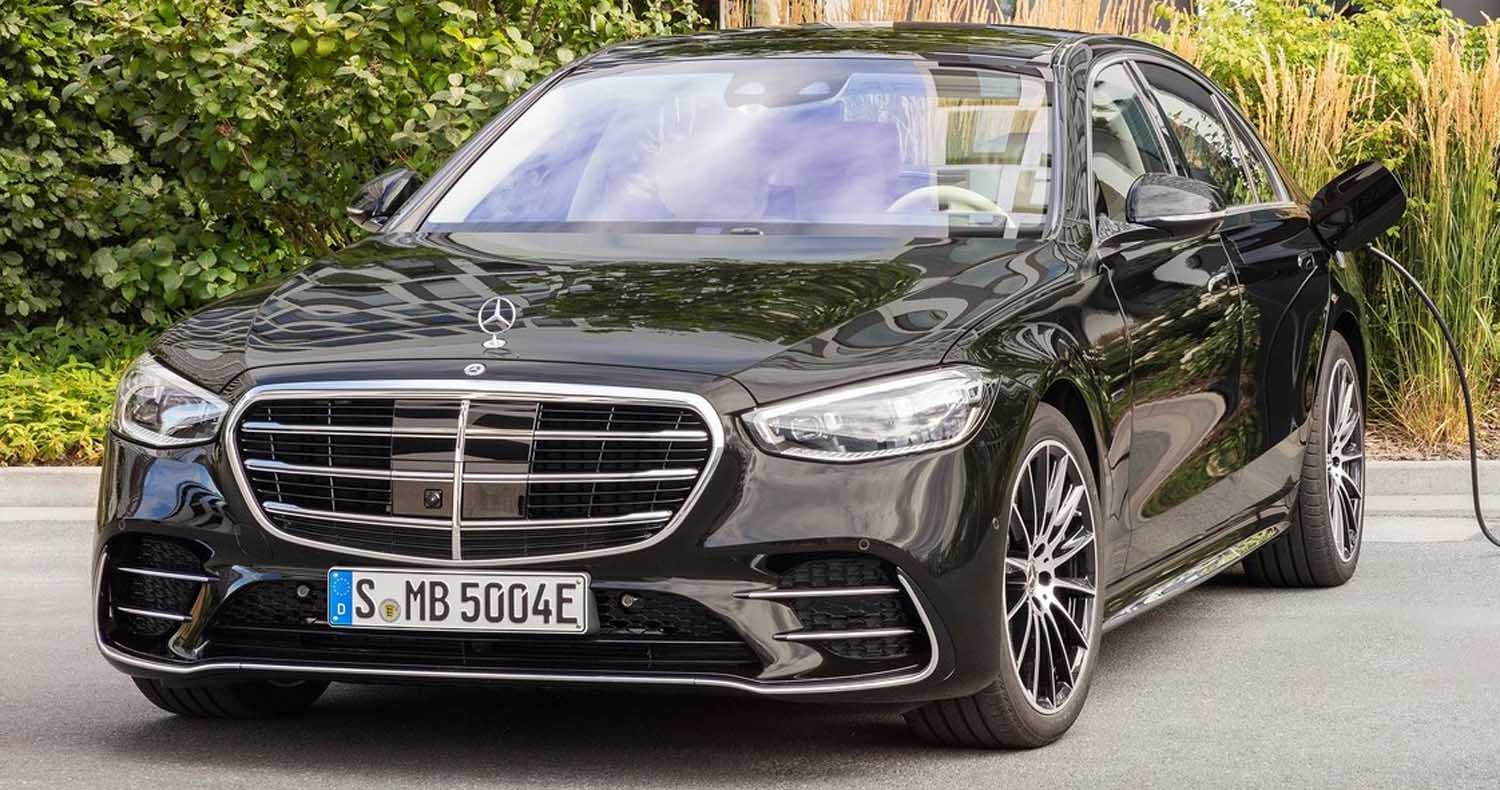
The S-Class stands for the fascination of Mercedes-Benz: legendary and traditional engineering expertise defines the luxury segment in the automobile industry. The new Mercedes-Benz S-Class can be experienced with all the senses – seeing, feeling, hearing and smelling – while offering numerous innovations in the areas of driver assistance, protection and interaction. Mercedes-Benz is shaping the next generation of individual mobility for our times with innovations that place the focus on people. The new S-Class uses digitisation for a car that responds empathetically to the needs and wishes of its driver and passengers.
Modern luxury reaches a new level with the interior of the S-Class. The designers have created a feel-good ambience with lounge character marked by elegance, high quality and airiness. The dashboard with its new architecture, modern surface design and ergonomic display arrangement is a noteworthy highlight. But the feel-good aspect goes even further: With high ride quality and low noise levels as well as an extensive range of ENERGIZING Comfort programs, the S-Class looks after the well-being of its passengers.
The new Mercedes-Benz S-Class has become more intelligent in many areas, including the driving experience, which is taken to the next level. Digital innovations such as in MBUX (Mercedes-Benz User Experience) are joined by new developments that increase driving enjoyment while making driving even safer: among them are rear-axle steering with a large steering angle and safety innovations such as the rear airbag. As a new function of PRE-SAFE® Impulse Side, the active E-ACTIVE BODY CONTROL suspension can raise the vehicle body (on both sides) just before an impending side impact. Following further systematic developments, the driving assistance systems take another step towards autonomous driving. Thanks to improved environmental sensors, for example, the parking systems provide the driver increased support when maneuvering at low speed. The integration into MBUX further enhances this as the level of visualization enters a whole new dimension.
For more than 100 years: the luxury class as the embodiment of the Mercedes-Benz brand
The Mercedes-Benz S-Class is the centerpiece of the brand, and exemplifies the allure of Mercedes-Benz as legendary engineering expertise and a heritage of craftsmanship meet progressive digital innovation. The S-Class combines artificial intelligence with the experience gained from 135 years of automobile engineering. Around 70 years ago, Mercedes-Benz laid the foundations for this model series with the model 220. Since its market launch in 1951, more than 4 million S- Class Sedans have been delivered to customers around the world. The designation “S-Class” was officially introduced with the 116 series in 1972. In the last 10 years the S-Class Sedan has been particularly popular in China, the USA, South Korea and Germany. All in all, since the launch of the generation that is now in its runout phase, more than 500,000 S-Class Sedans have been sold globally.
The loyalty rate for this model series is especially high. For example, around 80% of customers in Western Europe and 70% of customers in the US who previously drove an S-Class once again opted for a Mercedes-Benz model. Around the world the S-Class Sedan is predominantly sold in the long wheelbase version: Around 9 out of 10 customers opt for the long version of the S-Class Sedan.
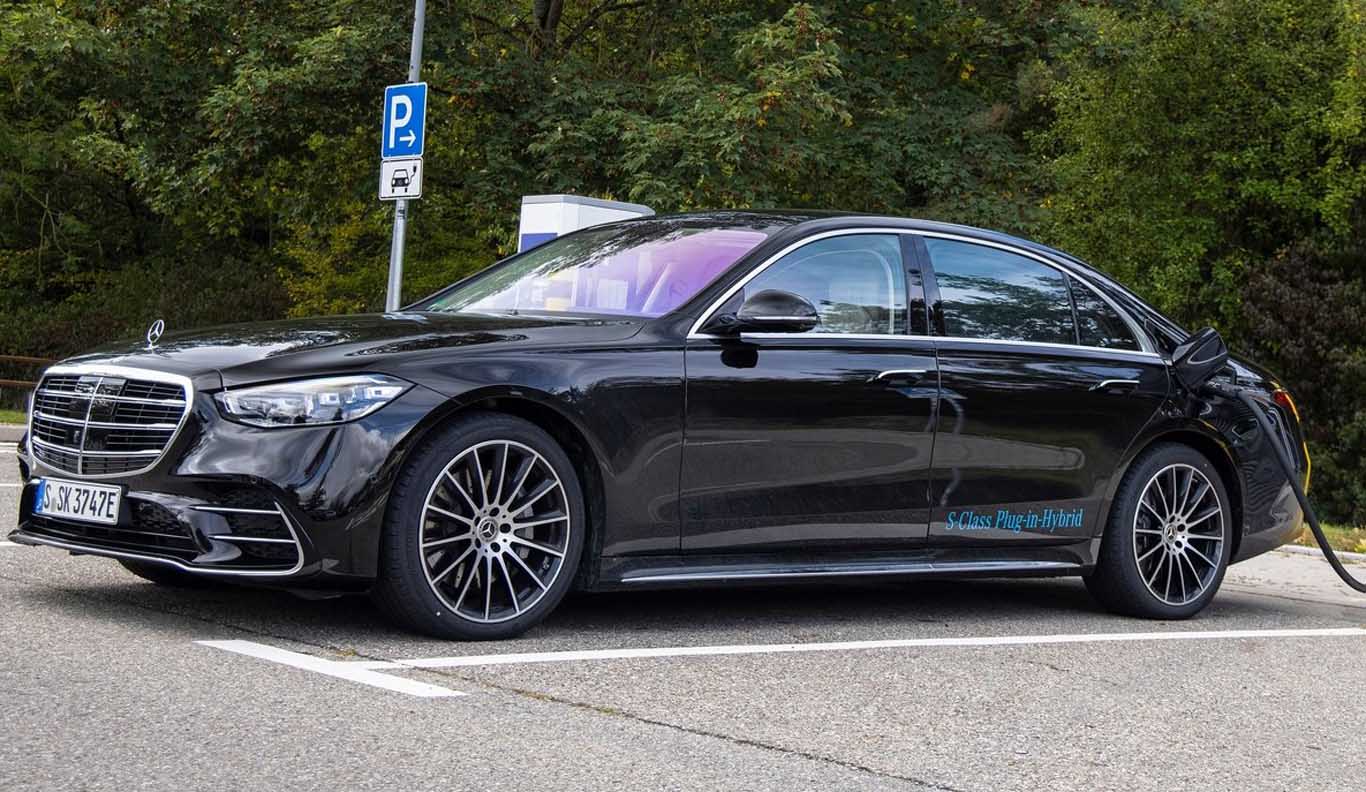
MBUX: a new dimension in personalization and interaction
No other innovation in recent years has so radically changed the operation of a Mercedes-Benz as MBUX (Mercedes- Benz User Experience) and now the second generation of MBUX makes its debut in the new S-Class. The vehicle interior is even more digital and intelligent, as both the hardware and software have made great strides: brilliant displays on up to five large screens, in part with OLED technology, make the control of vehicle and comfort functions even easier. The possibilities for personalization and intuitive operation have become far more extensive. This certainly applies in the rear, but also for the driver: For example, for the first time the new 3D driver display allows a spatial view at the touch of a button. Creating a real three-dimensional effect is achieved without having to wear 3D glasses.
The HUD provides augmented reality (AR) content. When navigating, for example, animated turn-off arrows (“fishbones”) are virtually and precisely projected onto the road lane. For the assistance functions, information from i.e. Active Distance Assist is shown. The image appears virtually at a distance of 32 feet, which corresponds with the display area to a monitor with a 77-inch diagonal screen.
The voice assistant “Hey Mercedes” is even more advanced and dialogue-capable through activation of online services in the Mercedes me App. Moreover, certain actions can be performed even without the activation keyword “Hey Mercedes”. These include accepting a telephone call. “Hey Mercedes” now also explains vehicle functions and answers general knowledge questions. In the S-Class the voice assistant can also be controlled from the rear seats.
Dimensional concept and interior design: generous ambience with a lounge-like feeling
The Mercedes-Benz S-Class has always been a place for comfortable travel and relaxed working. With the new generation, the interior has fully evolved into a “third place”, a refuge between the home and workplace. Nearly all comfort-related dimensions of the S-Class have been improved in the front as well as on the rear seats. The sense of space is accordingly generous.
The desired harmony between digital and analog luxury results in a revolutionary interior design, including inspiration from interior architecture and yacht design. The sculptured look of the dashboard, center console and armrests appears to float above an expansive interior landscape. The reduction in the number of controls also underscores the minimalist appearance of the interior, paired with a fine divide between the upper section of the dashboard and the large trim element structures to create horizontal breadth.
Alongside the potential for up to five screens, the highlights include the large areas of trim. These flow around the passengers and are a further systematic development of the wrap-around effect. One particularly attractive version of the trim is an open-pore wood veneer, shot through with inlays of real aluminum that follow the contours. New design elements include the flat, four-square center vents with horizontal nacelles. Two slim, vertical side vents on each side round off the ends of the dashboard.
The driver display and media display offer a comprehensive aesthetic experience. Adding to this, the appearance of the screens can be individualized with a choice of four display styles (Discreet, Sporty, Exclusive, Classic) and three modes (Navigation, Assistance, Service)
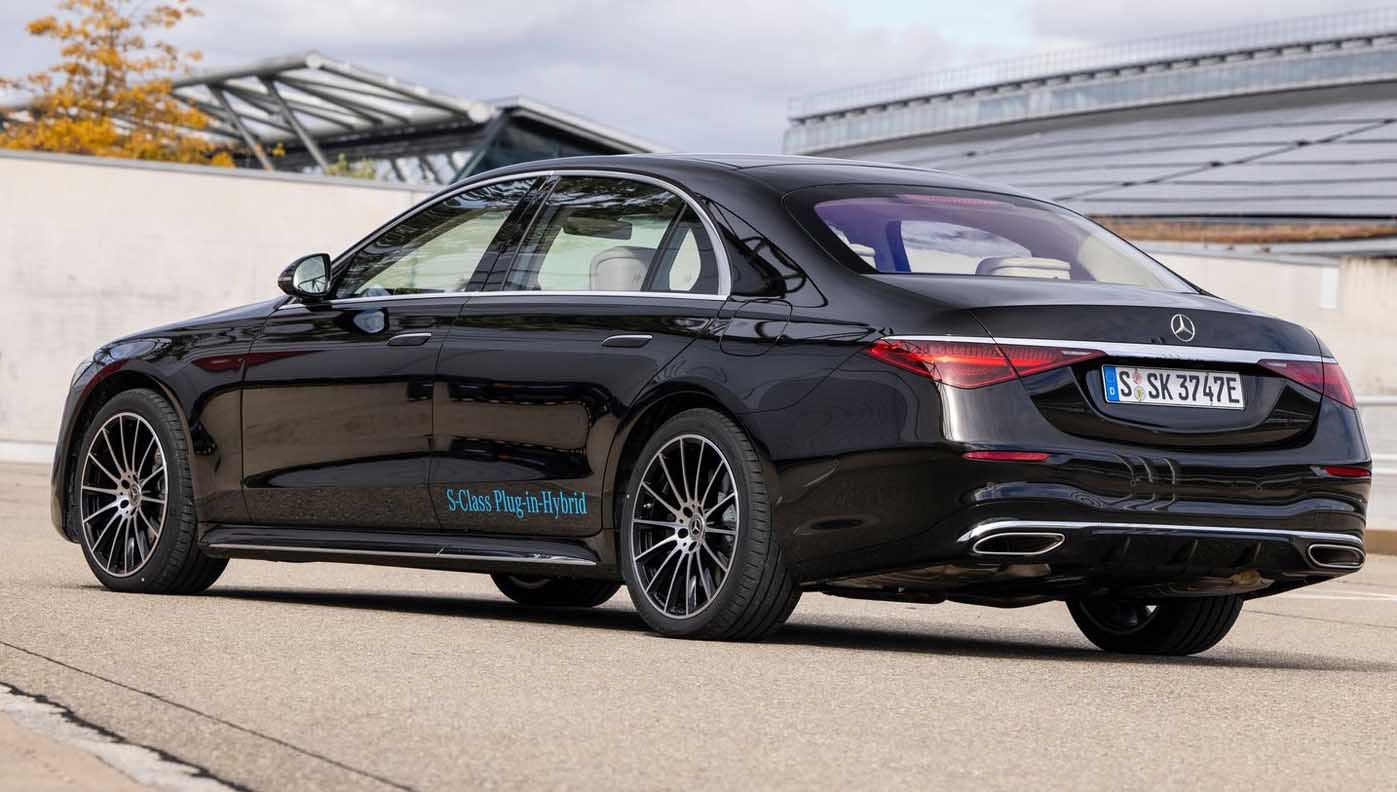
Seats: Plenty of high-tech for outstanding long-distance comfort
The seats invite the occupants to sit down and relax. The flowing, three-dimensional layer design theme gives an impression of lightness. While the various finishes give the seats different characters. For example, the progressive diamond pattern of nappa leather and Exclusive nappa leather provides a more classical and expressive appearance.
Up to 19 motors in the front seats make for comfortable seating – a number that indicates the complexity of the technology installed in the seats. The seats go beyond comfort as they also play a major part where safety is concerned.
And of course when it comes to luxurious wellbeing: all the seats available for the S-Class carry the seal of approval by the Healthy Seating campaign.
Ten different massage programs are available in the new S-Class. These use the vibration motors, and can enhance the effect of a relaxing massage with added warmth on the hot-stone principle. To create this, the seat heating is combined with the inflatable air chambers in the active multicontour seats. The air chambers are now closer to the seat surface, and are therefore even easier to control and feel.
The Executive Line allows for multiple rear seat variations, permitting customers to configure the rear of the S-Class as a working or rest area. One new feature is the heatable additional cushion for the head restraint, which is available for the two electrically adjustable rear seats. The adjustment range and angle of the front passenger seat in the chauffeur configuration and the reclining seat behind it have been improved as well.
The ENERGIZING COMFORT programs: Comfortable travel while staying healthy
At the touch of a button or by voice command, the holistic “Fit & Healthy” approach of ENERGIZING COMFORT provides a tangible experience of the different comfort systems in the S-Class, and features programs that bundle them into worlds of experience. At the same time, the system creates a suitable atmosphere in the interior – for example, a driver can select invigorating in the event of monotonous stretches of road, or relaxing if they are experiencing elevated stress levels. The ENERGIZING COACH can even suggests an appropriate vitalization or wellness program based on vehicle and trip data. It also factors in information about sleep quality and stress level into its intelligent algorithm if the driver has a compatible wearable device.
Mercedes-Benz has fundamentally improved ENERGIZING comfort control in the new S-Class with innovations such as a massage based on vibrating motors in the seat cushion and integrated resonance transmission through the optional Burmester® high-end 4D surround sound system, which makes bass tones tangible. Direct reproduction of the sound resonance in the seats adds another level to the three-dimensional listening experience – 4D sound inspired by the acoustic massage. The perceived intensity of the sound can be individually adjusted for each seat. The music becomes even more evocative thanks to this tangible component. Two resonators are integrated into the backrest of each seat for this purpose.
Driver assistance systems: even more support for the drive
In the new S-Class, Mercedes-Benz takes another step closer to its vision of accident-free driving. The driver is supported by numerous new or extended driving assistance systems. As a result, the driver experiences a reduced workload in day-to-day situations, and is able to drive comfortably and safely. When a dangerous situation is detected, the assistance systems are able to respond to impending collisions as the situation demands. The operating principle of the systems is made apparent through a new display concept in the driver display.
Thanks to improved environmental sensors, the parking systems provide the driver increased support when maneuvering at low speed. Operation is faster and more intuitive thanks to integration into MBUX. The optional rear-axle steering is integrated into the parking assistants, with the calculation of trajectories adapted accordingly. Emergency braking functions also serves to protect other road users.
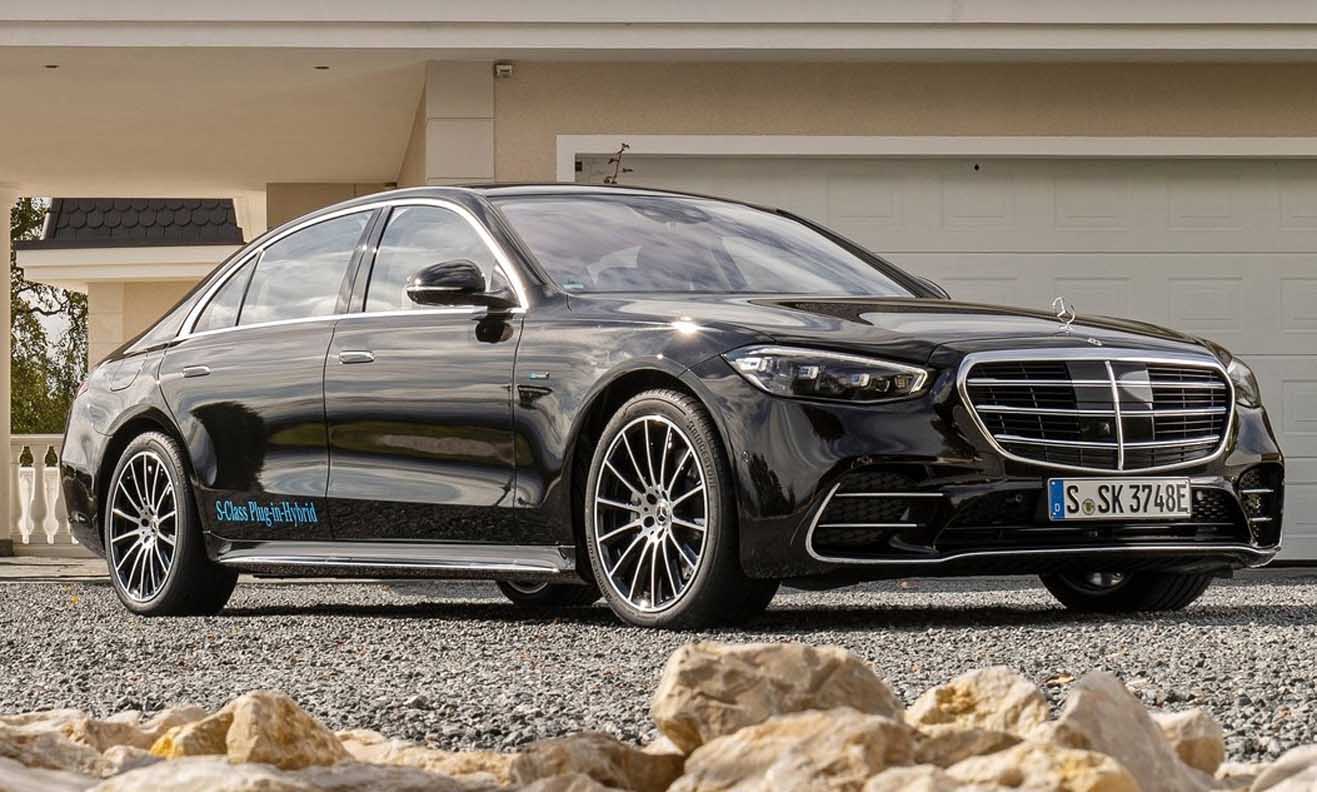
Suspension systems: more maneuverable and dynamic with rear-axle steering
Innovative suspension systems ensure an impressive travel experience in the new Mercedes-Benz S-Class. Rear-axle steering (optional) with a steering angle of up to 10° improves maneuverability on narrow city streets to the level of a compact car. For the S-Class with a long wheelbase and all-wheel drive, the turning circle is reduced by 6.2 feet to under 35.8 feet.
The fully active E-ACTIVE BODY CONTROL suspension on a 48 V basis offers a unique synthesis of comfort and agility, plus additional protection in the event of a lateral collision. The AIRMATIC air suspension with continuously adjustable damping ADS+ comes standardly equipped. Close networking between all the suspension and control systems ensures maximum stability and safety. Mercedes-Benz has now added a new function of PRE-SAFE® Impulse Side, when equipped with E-ACTIVE BODY CONTROL, to its measures in the pre-accident phase: When a side impact threatens, the vehicle body can be raised by up to 3 inches by the E-ACTIVE BODY CONTROL suspension within a few tenths of a second. This reduces the loads on the door structures, as the door sill can absorb more of the impact thanks to its higher position. As a result, deformation of the passenger cell and the loads acting on the occupants can be reduced. Radar sensors are used to recognize a potential side crash.
Exterior design: perfect proportions for a classical appearance
With a short front overhang, a long wheelbase and a balanced rear overhang, the Mercedes-Benz S-Class is designed as a classical sedan with perfect proportions. The wide track and flush-mounted wheels with modern designs give the vehicle a muscular look. The character lines have been greatly reduced along the sides with cleverly contoured surfaces and a sculptured look to create special light effects. The front section is also notable with its high-status radiator grille.
The headlamps characterize the front of the car. With the three-point daytime driving light signature that is typical of the Mercedes-Benz S-Class, now flatter and slightly smaller overall. The seamless door handles (standard) are a completely new development. They are electrically extended when the driver approaches, or the outer surface of the door handle is touched. Keyless access is provided by KEYLESS-GO.
The dynamic appearance of the car is continued at the rear. Thanks to precisely designed, highly detailed interior features and certain animated functions, the rear lights contribute to the impression of high quality, making the new S- Class unmistakable in both their day and night design.
The lights: with innovative technology
Thanks to LED technology, the new S-Class has also taken a leap forward in its interior lighting: Mercedes-Benz has now realized interactive interior lighting for the first time. The active ambient lighting (optional) is now integrated into the driving assistance systems, and is able to reinforce alerts visually. This also makes corresponding feedback possible for the comfort systems. This applies to the climate control system or the ‘Hey Mercedes’ voice assistant.
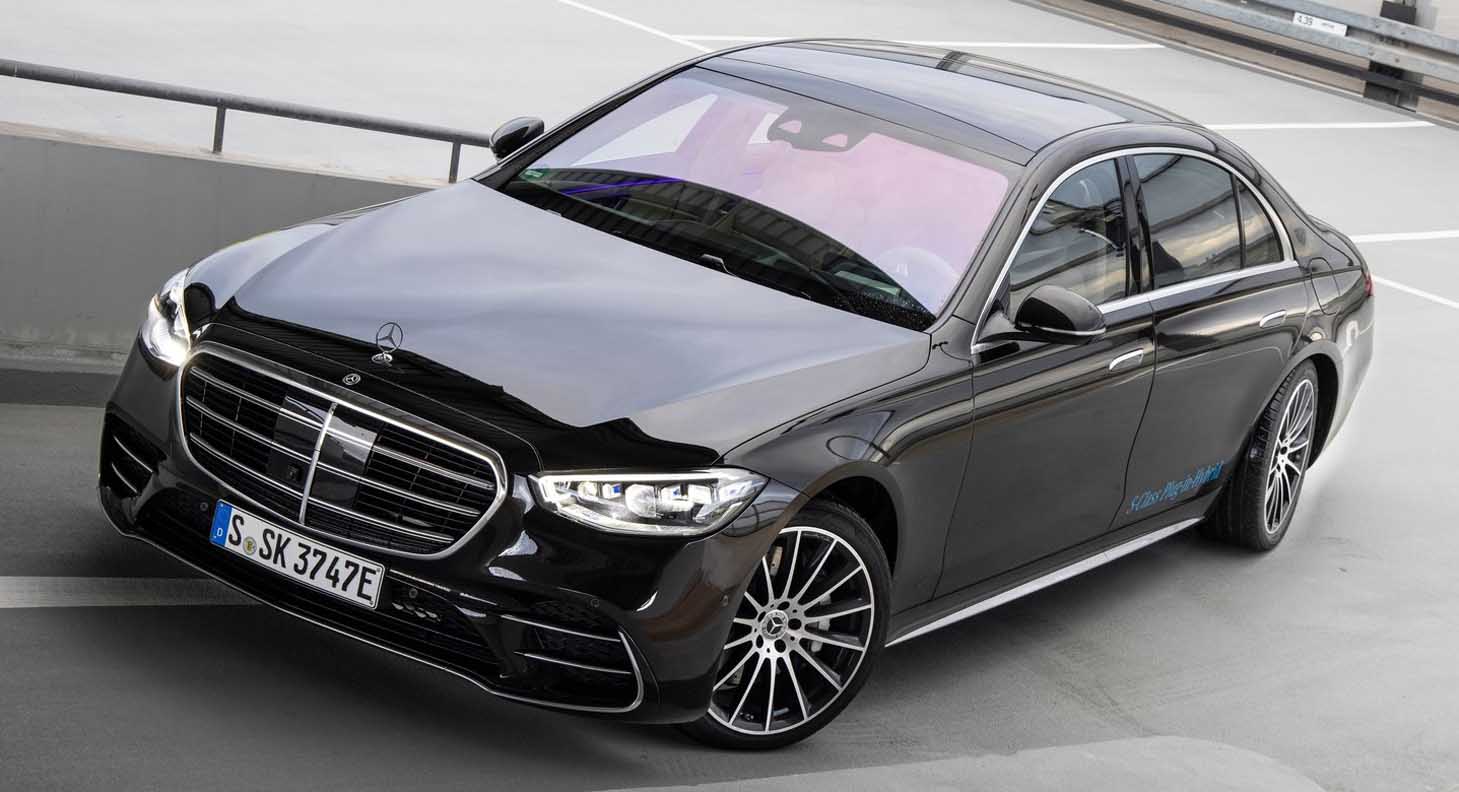
Aerodynamics: extensive airflow simulations in the early development phase
With a C figure from 0.22, the Mercedes-Benz S-Class is one of the world’s most aerodynamic cars, and especially so in the luxury sedan segment. Although the frontal area (A) of the new S-Class has increased slightly to 2.5 sq. m., the drag coefficient has been reduced even further compared to the preceding model. The product of Cd and A is 0.56 sq. m., which is 200 sq. cm less than for the previous model after its last facelift. Aerodynamic measures affecting the body, underbody and detachable parts allow improved performance in the wind tunnel and in real operation. Extensive airflow simulations were already carried out using high-performance computer clusters during an early development phase.
The S-Class has also achieved further improvements in aeroacoustics. The new model is even quieter than the previous generation that already excelled with a very high level of interior noise comfort. The high rigidity of the bodyshell provides the basis for outstanding noise and vibration comfort, this is now enhanced with fine-tuning. For example, the apertures for the cable grommets in the firewall have double seals. To achieve an engine sound that is perceived as refined and unobtrusive in the interior, the firewall insulation has been extended into the side areas of the A-pillars and the floor area. Mercedes-Benz is also using acoustic foam in certain bodyshell sections for the first time.
Powertrain: more electrification, more efficiency
Six-cylinder in-line petrol and diesel engines in various output classes are the first engine variants for the new S-Class.
A V8 engine with an integrated starter-generator (ISG) and 48-volt onboard electrical system will be available soon after. A plug-in hybrid with an all-electric range of around 100 kilometres will follow in 2021.
Vehicle body and accident protection: new frontal airbags for rear passengers
Intelligent bodyshell design and innovations in restraint systems reinforce the leading role of the S-Class when it comes to passive safety. The new aluminum hybrid bodyshell with an aluminum content exceeding 50 percent meets numerous requirements: A high level of crash safety, lower weight and a highly rigid bodyshell all ensure outstanding handling characteristics accompanied by excellent noise and vibration comfort.
In 2019, in the Experimental Safety Vehicle ESF 2019, Mercedes-Benz presented ideas that the company’s safety specialists were working on. Within the ESF more than 20 innovations were near-series developments, such as the rear airbag, which is now available as optional equipment in the S-Class. The frontal airbag for the rear seat deploys particularly gently thanks to its innovative construction using a tubular structure. During severe frontal collisions, the rear airbag can considerably reduce the impact on the heads and necks of seat belt wearing occupants on the outer rear seats.
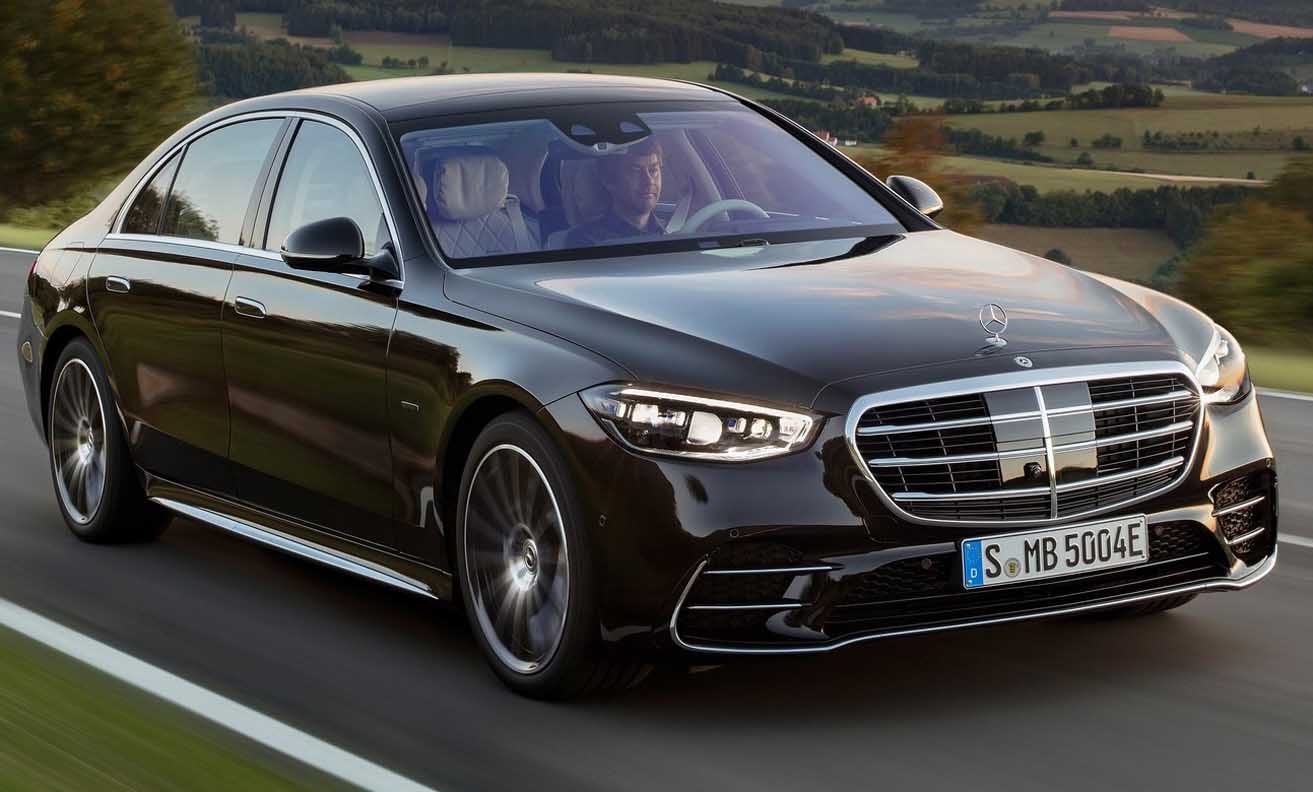
Sustainability: environmentally compatible development
More than 216 lbs of components made from resource-conserving materials are used in the S-Class. The number of components containing recyclates is now 120 – more than twice as many as in the preceding model. Another 88 lbs or so are made from renewable raw materials. The process of environmentally compatible development with specific targets is firmly embedded in the overall development process. Environmental aspects are already taken into account in the conceptual phase.
A new, recycled thread is now used for the floor coverings. This thread – brand name ECONYL® – consists of regenerated Nylon. It is manufactured by recovering Nylon waste destined for the landfill, for example old fish nets and fabric remnants from mills and carpets. These are collected and transformed into a new thread having the same properties as nylon from new raw materials. The recycling process used to produce the thread saves CO2 in comparison with new production. It also enables Mercedes-Benz to keep materials in circulation.
History: setting the standard for the luxury class for many decades
The Mercedes-Benz S-Class follows a long tradition that extends back to the beginnings of the Mercedes brand in the early 20th Century. Each model has decisively influenced the automotive engineering of its era. Well before the official designation S-Class, the models in the executive and luxury class were the mainstay of the Stuttgart-based company’s portfolio and have always stood for luxury, comfort, safety and lifestyle. The continuous ancestry of the S-Class begins with the model 220 (W 187) of 1951. The designation “S-Class” was officially introduced with the 116 series in 1972.
Light and comfortable travel
Innovative suspension systems ensure an impressive travel experience in the new S-Class. Rear-axle steering with a steering angle of up to 10° improves manoeuvrability in urban areas. The optional, fully active E-ACTIVE BODY CONTROL suspension on a 48 V basis offers a unique synthesis of comfort and agility, plus additional protection in the event of a lateral collision. The AIRMATIC air suspension with continuously adjustable damping ADS+ is standard equipment. Close networking between all the suspension and control systems ensures maximum stability and safety. Redundant steering and braking systems are ready for conditionally automated driving acc. to SAE Level 3.
The aim of the developers was to exceed the high level of suspension and ride comfort of the preceding series, while achieving a very high level of vehicle dynamics. E-ACTIVE BODY CONTROL (see separate chapter) replaces the previous MAGIC BODY CONTROL.
At the front the new S-Class has the well-proven four-link suspension. With the exception of the wheel bearings, all the wheel location components are of forged aluminium. The multi-link independent rear suspension has been completely redeveloped to accommodate rear-axle steering. To this end, the kinematics and elastokinematics were adapted, and the track rod at the lower steering arm level was moved from the front to the rear. The rear axle carrier is of welded sheet aluminium, and weighs no more than before thanks to computer-assisted structural improvements and despite greater strength. A newly developed metal/plastic hybrid cross-bar is bolted into this open-fronted section, and has significant weight advantages over the cast aluminium cross-bar of the preceding model. The suspension subframe carriers and the elastomer bearings of the rear axle struts were redeveloped in extensive simulations and driving trials, so as to improve them with respect to NVH and handling characteristics.
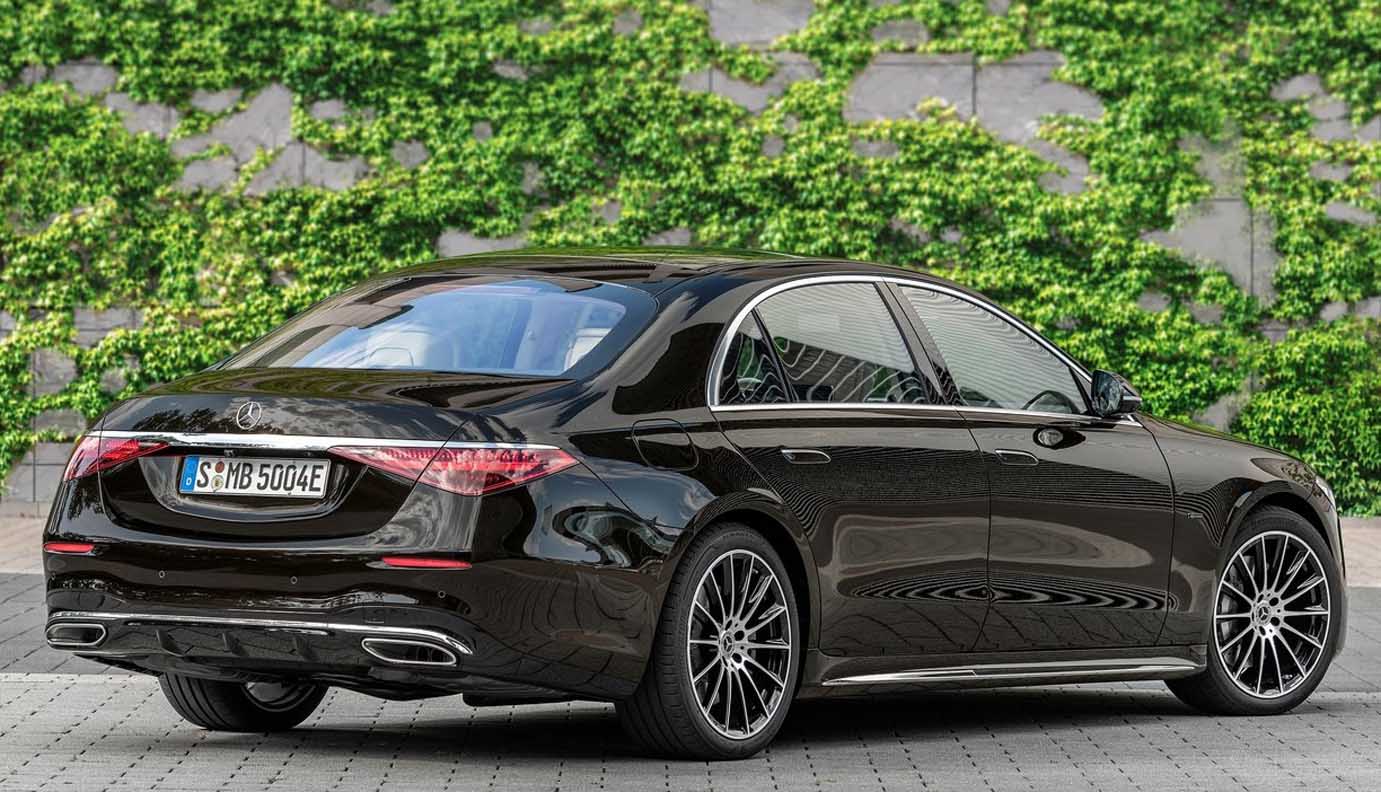
Constant level
The standard-fit AIRMATIC air suspension responds particularly sensitively. It combines air suspension bellows with adaptive ADS+ dampers whose characteristics can be fully automatically varied at each individual wheel, in both the compression and rebound stages. While driving, a sophisticated sensor system and algorithms set the dampers according to the quality of the road to ensure that, for example, driving over a bump with just one wheel is not transmitted to the entire axle and the interior. At the front axle the springs and dampers are housed in one suspension strut. This level control is part of AIRMATIC. It keeps the ground clearance constant irrespective of the vehicle load, but also makes changes. By way of example, in COMFORT mode the vehicle body is lowered by 10 mm at high speeds above 120 km/h and another 10 mm at over 160 km/h to reduce aerodynamic drag and increase driving stability. In SPORT driving mode the body is always 10 mm lower, and in SPORT+ 17 mm. At up to 60 km/h, the body can be raised by 30 mm at the touch of a button.
As manoeuvrable as a compact car: both axles can do the steering
The aim of the engineers at Mercedes-Benz was to make the new S-Class as manoeuvrable as a compact car. The impressive driving function has been realised using rear-axle steering that allows large steering angles of up to 10° and is integrated into the dynamic control systems of the steering, brakes and suspension (more about the rear-axle steering in the next chapter). The S-Class has an electro-mechanical direct steering system at the front. The suspension settings of the DYNAMIC SELECT driving modes allow individual adaptation of the assistance characteristics. Whatever the vehicle weight, tyre size and friction, an innovative control concept ensures consistent and comfortable steering feedback. The steering is also the central actuator for implementing the movement trajectory from numerous driving assistance functions and handling safety systems. In models equipped with the optional rear-axle steering, the front axle has a steering variant with an approx. 15% more direct steering ratio which requires considerably less steering movement in conjunction with the rear-axle steering.
DYNAMIC SELECT: The S-Class drives as the driver wants it to
The driver can individually modify the characteristics of the powertrain, ESP®, suspension and steering. The selection is made using a control at the lower end of the central display. The default setting is COMFORT mode. Different characteristics are firmly assigned to each system. The driver has the choice of selecting fixed driving modes or individually combining sub-modes. The selection is acknowledged by acoustic and visual feedback. The desired driving mode is shown as the status and depicted in the central display.
The CURVE mode is also available in combination with E-ACTIVE BODY CONTROL. Plug-in hybrid models have the BATTERY LEVEL and ELECTRIC driving modes.
Electronic assistance: ESP® dynamic cornering assistance and Steering Assist
The steering assistant STEER CONTROL responds with commensurate steering force at the dynamic limits to support the driver in stabilising the vehicle. To do this, the electronics determine the direction in which the driver must steer to defuse a potentially critical situation, and ensure a corresponding steering movement to indicate the steering direction that will enable the vehicle to be stabilised. For example, ESP® dynamic cornering assistance brakes the inner rear wheel if the electronics detect understeer. Both high handling safety and high driving dynamics are the result.
In combination with the DRIVE PILOT: steering for conditionally automated driving
It is expected that from the second half of 2021, the Mercedes-Benz S-Class will be able to drive in conditionally automated mode at up to 60 km/h with the new DRIVE PILOT where traffic density is high or in tailbacks on suitable motorway sections. The technology for this includes fail-safe steering which executes the relevant actuation and steering commands of the intelligent track guidance system with the greatest precision. Embedded in a twin-channel architecture, this steering relies on a multiple back-up energy supply via independent bus-systems with the vehicle components involved. The front and rear axle have twice the number of rpm sensors.
All the major electronic and electro-mechanical components, assemblies and sensors are redundant in nature. In the event of a channel failure, the redundant component continues the function. The electric motor consists of four sub-motors, so that at least 50% of the maximum output is available at any time. This ensures that during conditionally automated driving, the desired trajectory can be followed by the front axle steering in any situation.
An electric brake booster is used for models with additional equipment for conditionally automated driving, or e.g. the optional Remote Parking Assist or the INTELLIGENT PARK PILOT. To reinforce the driver’s braking intention, this does not use vacuum pressure but an electric motor with a reduction gear. During conditionally automated driving or parking manoeuvres, the electric brake booster acts as a redundant pressure generator for the braking system and can bring the vehicle to a safe stop even if the hydraulic unit fails.
Modern luxury in its most desirable form
The Mercedes-Benz S-Class is seen as a trendsetter in its segment. Together with its model variants, the luxury saloon is a point of reference and an example for the automobile industry. The new generation continues this tradition. The interplay between emotion and intelligence becomes tangible, and arouses desire for the brand and for the S-Class itself. Innovation in combination with the latest technology and traditional craftsmanship make the vehicle unique.
With a short front overhang, a long wheelbase and a balanced rear overhang, the S-Class is designed as a classical saloon with perfect proportions. Other unmistakable exterior features include the stretched bonnet, the upright front end with the mounted star, the long passenger cell and the flowing C-pillar with its sculptured shoulder. The claim of the S-Class to high status is indicated by the excellent prestige measurement, i.e. the distance from the front axle to the windscreen. The wide track and flush-mounted wheels with modern designs give the vehicle a muscular look.
The so-called character lines have been greatly reduced along the sides. Cleverly contoured surfaces with a sculptured look create special light effects. At the same time they embody the Mercedes-Benz design philosophy of sensual purity. Chrome elements stylishly positioned by the designers – e.g. as a decorative lower strip on the side sills – further embellish the S-Class and accentuate its length.
The front section impresses with its high-status radiator grille. The numerous sensors and cameras of the assistance systems are attractively and symmetrically integrated into the design, and deliberately accentuated as high-tech elements.
The headlamps characterise the front aspect of the car. They have the three-point daytime driving light signature that is typical of the S-Class, but this is flatter and somewhat smaller overall. The new light system DIGITAL LIGHT (see separate chapter) is available as an optional alternative to the standard MULTIBEAM LED headlamps. This headlamp has a distinctive look, and is distinguished by e.g. the blue light of its floor facing.
Flush-fitted door handles (optional) and sophisticated wheel designs (size 18 to 21 inches) accentuate the side aspect. The dynamic appearance of the car is continued at the rear. Details such as the two visible exhaust tailpipes contribute to an unmistakable appearance that is typical of a Mercedes-Benz. They are accompanied by the surprising design of the boot lid in combination with the progressive, two-section rear lights. The chrome strip at the upper edge of the rear lights accentuate the width of the rear.
Thanks to precisely designed, highly detailed interior features and certain animated functions, the rear lights contribute to the impression of high quality. They make the new S-Class unmistakable in both their day and night design.
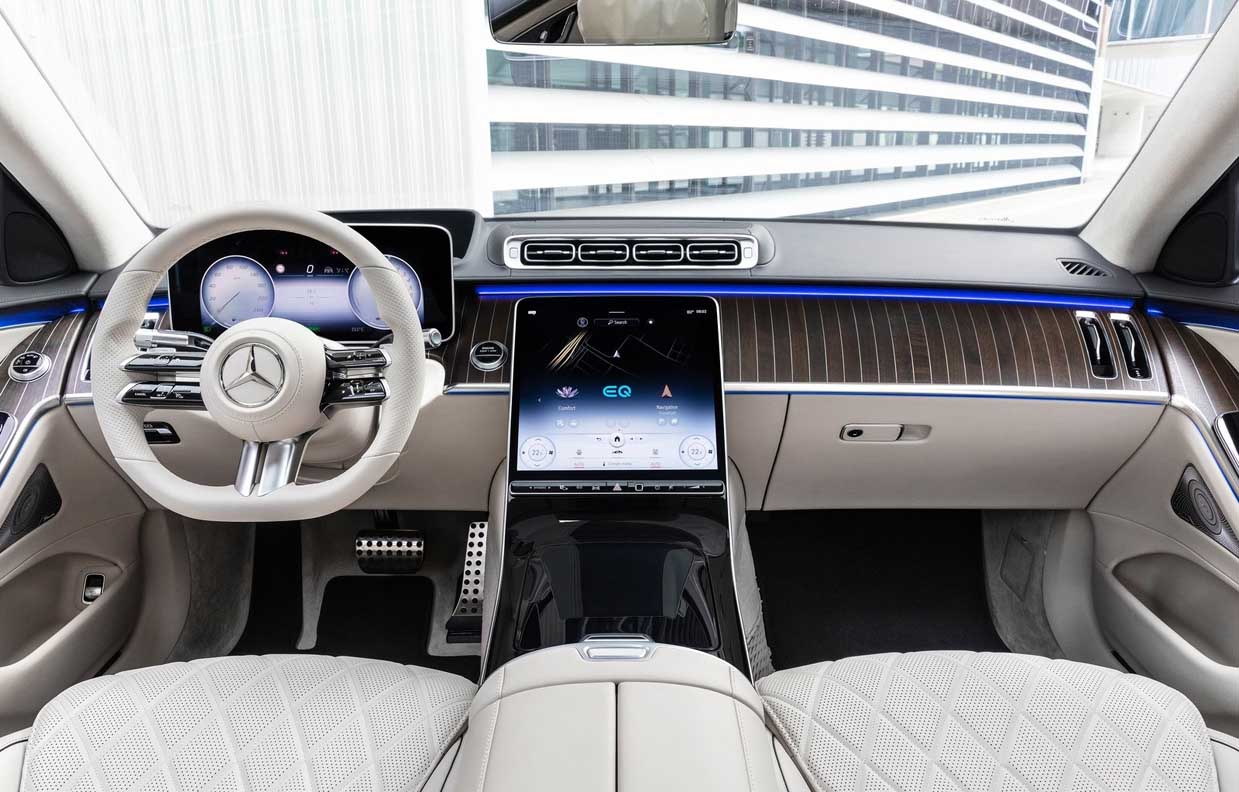
Digital-analogue revolution in the interior
Modern luxury attains the next level in the interior of the S-Class. The designers have created a feel-good ambience with lounge character marked by elegance, high quality and lightness. The dashboard with its new architecture, modern surface design and ergonomic display arrangement is a particular highlight. The aim and ambition of the Mercedes-Benz interior designers was to harmonise digital and analogue luxury in the vehicle interior.
The Mercedes-Benz S-Class has always been a place for comfortable travel and relaxed working. With the new generation, the interior has fully evolved into a “third place”, a refuge between home and workplace. Nearly all comfort-related dimensions of both variants, the S-Class with short and long wheelbase, have been improved in the front as well as on the rear seats. The sense of space is accordingly generous.
The desired harmony between digital and analogue luxury results in a revolutionary interior design, including associations with interior architecture and yacht design elements. The sculptured look of the dashboard, centre console and armrests appears to float above an expansive interior landscape. The systematic reduction in the number of controls underscores the minimalist appearance of the interior. A fine divide between the upper section of the dashboard and the large trim element structures the area and creates horizontal breadth. This interface is also where the active ambient lighting (see separate chapter) is located.
In addition to the up to five screens, highlights include the large trim elements in the dashboard and in the rear (with the First Class rear suite). These flow around the passengers and are a systematic further development of the wrap-around effect. One particularly attractive version of the trim is an open-pored wood veneer shot through with inlays of real aluminium that follow the contours. The “Novum” trim variant consists of a mixed metallic weave which accentuates the elegant, sporty styling.
New design elements include the flat, four-square centre vents with horizontal nacelles. Two slim, vertical side vents on each side round off the ends of the dashboard. The air volume is controlled by keys with LED displays. The avantgarde geometry of the vents and their decorative nature accentuate the modern look.
The seats (see separate chapter for features and configuration) invite the occupants to sit down and relax. The flowing, three-dimensional layer design theme gives an impression of lightness. Different finishes give the seats different characters. For example, the flowing longitudinal piping of Lugano leather lends them a noble, avantgarde look, while the progressive diamond pattern of nappa leather and Exclusive nappa leather is more classical and expressive.
Mercedes-Benz introduced electric seat adjustment in 1980. Since then, many vehicle generations have featured the brand’s hallmark seat adjustment switch in the form of a stylised seat in the door. This control has been completely redesigned for the new S-Class. Visible joints have been reduced by combining the trim with the seat controls. The geometry and surround lighting of the control panel make the seat adjustment control appear to float in the door panel.
The newly developed pressure sensors for seat adjustment open up new design possibilities. Thanks to the practically fixed control buttons, minimal gaps between the individual controls can be realised. This also means that very small apertures in the black panel trim are possible. This allows a slim, filigree, floating design of the control buttons. The pressure sensors also allow a continuous coupling of operating pressure and speed.
Choice of four display styles and three modes
The driver display and media display offer a comprehensive aesthetic experience The appearance of the screens can be individualised with a choice of four display styles (Discreet, Sporty, Exclusive, Classic) and three modes (Navigation, Assistance, Service) Examples of new features:
- In “Discreet”, seven different colour schemes are available for the instrumentation, and the 64 colours of the ambient lighting are grouped accordingly.
- “Sporty” is dominated by the colour red, with dynamic presentation of the central rev counter.
- The new display scheme “Exclusive” in an attractive white mother-of-pearl look is reserved for the S-Class. In night mode and when passing through tunnels, the system automatically switches to a darker display.
- In “Assistance” mode, important events, the infrastructure and other road users (cars, motorcycles, trucks) are shown.
- The augmented reality head-up display (see separate chapter) is absolutely new, and projects important information into the real environment.
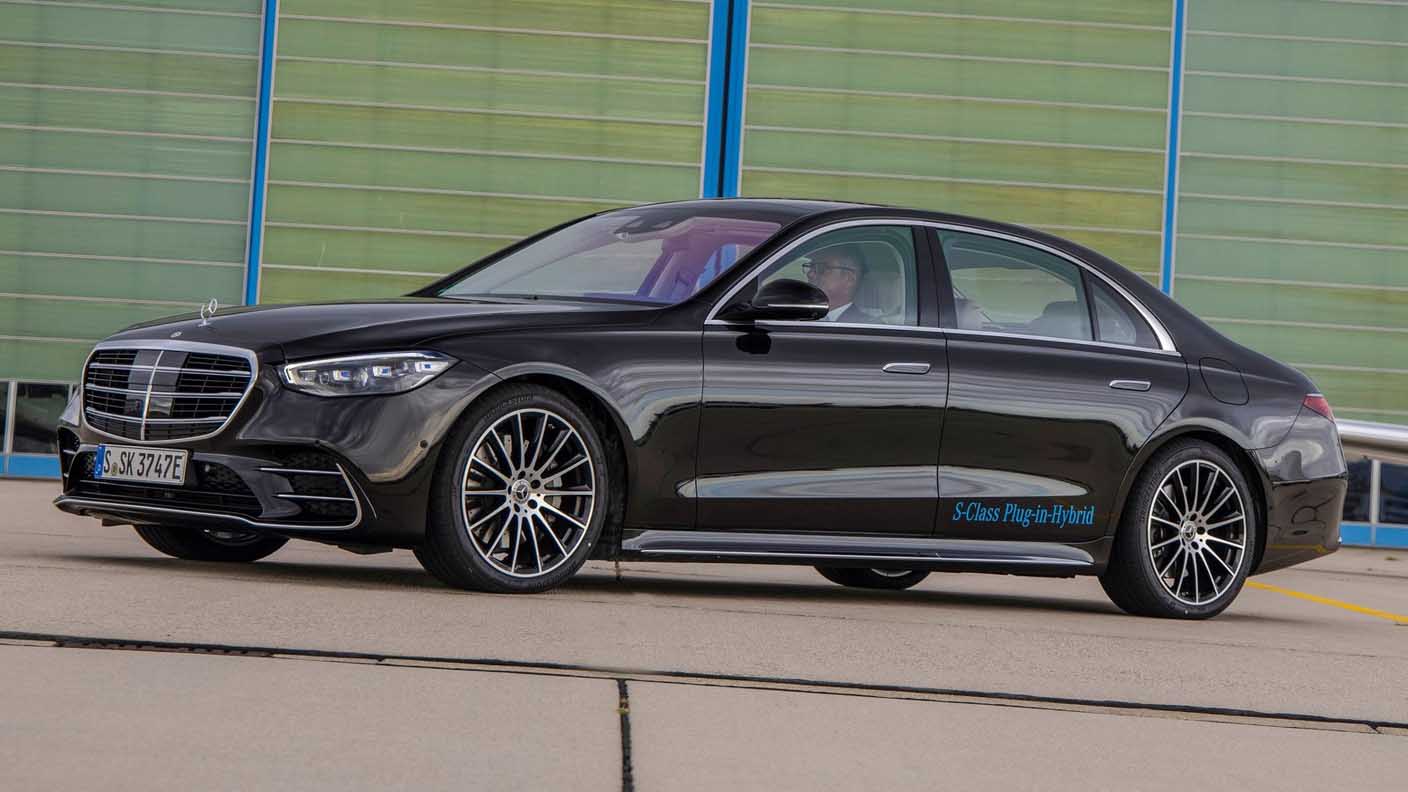
Stable, light and safe
Intelligent bodyshell design and innovations in restraint systems confirm the leading role of the S-Class when it comes to passive safety. The new aluminium hybrid bodyshell with an aluminium content exceeding 50 percent meets numerous requirements: A high level of crash safety, up to 60 kg less weight and a highly rigid bodyshell ensure outstanding handling characteristics accompanied by excellent noise and vibration comfort.
The bodyshell of the new Mercedes-Benz S-Class was designed with a particular focus on lightweight construction. The newly developed aluminium/steel hybrid bodyshell increases the aluminium content to more than 50 percent by weight. The high proportion of aluminium is achieved by using cast and extruded structural components. This form of lightweight design and construction requires highly complex joining techniques. It demonstrates the know-how of Mercedes-Benz in the luxury saloon segment, as well as the quality arising from close, barely perceptible body joints and the highly precise fit of the design surfaces.
The extensive package of lightweight construction measures includes rigid extruded aluminium sections for the side members in the front, rear and sides. Specially developed, highly integrated diecast aluminium components are used at important nodal points in the structure.
The extremely stable side wall structure comprises the pillars, the side roof frame and the side members. The material mix of aluminium and high-strength steel alloys helps to reconcile the conflicting aims of lightweight design and crash resistance. The inner shells are partly made up of several components, with particularly large areas for the nodal points between the pillars, roof frame and side members according to the potential loads.
One-piece aluminium side wall panels are a highly effective lightweight construction feature. Particular importance was given to achieving close joints and high-quality radiuses. The body panels of the roof, bonnet, wings, boot lid and doors are also of sheet aluminium.
Passenger cell: protected by ultra high-strength and press-hardened steel
The Mercedes-Benz safety cell is the centrepiece of the safety system. It has a structure of hot-formed high-strength steel cross-members in the areas of the firewall and rear end. At the sides this is complemented with extremely rigid side sills of extruded aluminium sections, which are larger than in the preceding model, with four internal chambers.
The floor structure likewise has ultra high-strength and press-hardened steel alloys combined to form a highly functional platform. The loads arising in all impact scenarios are conducted into the main floor. The robust centre tunnel and the lateral side members provide the basis for this. These assemblies are connected using further cross-members and diagonal struts. The design of this support structure makes the use of lighter floor panels possible. These make a major contribution to weight efficiency. The load resistance of the tunnel, which is especially important for frontal impacts, is achieved using connected sections of high-strength steel. The wall thicknesses vary according to expected loads.
Front: Protection of other road users
The front structure consists of an annular upper structure, the side members and the integral carrier. Additional polymer connecting elements between the crash levels ensure particularly effective energy absorption in the early phase of a crash. The integral carrier supports the engine, steering and lower suspension arms, and uses a special crash support system to direct longitudinal forces into the floor structure during a frontal collision. In the case of semi-overlapping collisions, the cross-connections in the front section are able to activate the side unaffected by the impact, e.g. the right side of the structure in case of a semi-overlapping collision on the left, and vice versa.
In cases of heavier deformation, the wheels are supported against the rigid side wall and the wheel impact element positioned ahead of it. The geometry and strength of the side sills are configured accordingly. Above the pedal floor panel the firewall is reinforced by an exterior cross-member of high-strength steel, which is supported by the A-pillars.
As well as occupant protection, compatibility with other road users was an important development objective. For this purpose, as an addition to the previous concept, the front flexural member is designed to provide an even more stable and broad impact surface for the other vehicle in an accident, for example.
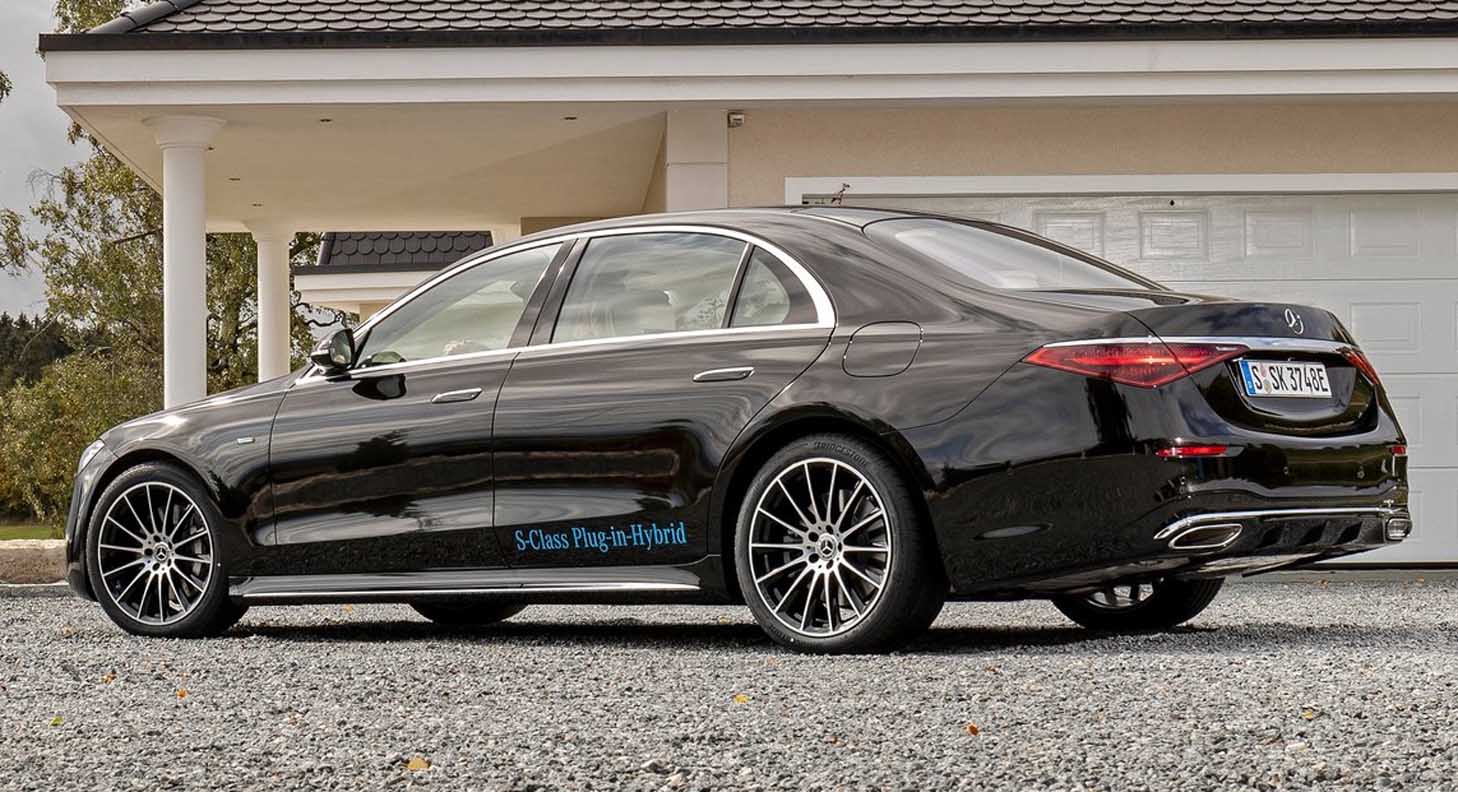
Rear section: two zones with different purposes
The safety level of the rear structure is mainly achieved by a division into two crash zones. The zone housing the fuel tank components is kept almost deformation-free by cast aluminium sections. The purpose of the crumple zone behind this is mainly to dissipate impact energy with the help of extruded aluminium structures. In the case of a semi-overlapping collision, the rear flexural member directs the loads into the side unaffected by the impact, so that both side member paths can be activated.
Restraint systems: innovations for passengers in the rear
Especially in the Mercedes-Benz S-Class, particular attention has always been paid to safety in the rear. In this respect, Mercedes-Benz has long devoted itself to extending the airbag and belt systems. Large windowbags cover the side windows like a curtain. These can be triggered according to the type of impact, e.g. a severe lateral collision or a rollover. The outer seat belts are equipped with belt tensioners and belt force limiters as standard, helping to reduce the loads acting on the occupants. Rear sidebags are optionally available, as is the beltbag: as an inflatable belt strap it distributes the loads acting on the upper body over a wider area.
The rear airbag is an innovation by Mercedes-Benz: this additional airbag can further improve the safely level of passengers in the rear during a severe frontal collision (see “Under the microscope”). However it still remains important for the occupants to wear seat belts. In the rear this is made more intuitive by the optional, illuminated designer belt buckles.
More electrification, more efficiency
When the new Mercedes-Benz S-Class is launched, six-cylinder in-line petrol and diesel engines in various output classes will be available, with a V8 engine with integrated starter generator (ISG) and a 48-volt onboard electrical system to follow shortly afterwards. A plug-in hybrid with an all-electric range of around 100 km will follow in 2021.
With the introduction of the integrated starter-generator (ISG) in the S-Class powered by the M 256 six-cylinder in-line engine in 2017, the 48 volt onboard electrical system celebrated its world premiere. The ISG is responsible for hybrid functions such as boost or energy recovery, while allowing fuel savings that were previously reserved for high-voltage hybrid technology. The systematically electrified six-cylinder in-line engine in the new Mercedes-Benz S 500 4MATIC has an output of 320 kW/435 hp and 520 Nm of torque. EQ Boost provides a further 250 Nm of torque as well as 16 kW (22 hp) for a short period.
Intelligent, forced induction that includes an electric booster compressor, as well as the integrated starter alternator (ISG) provide outstanding power delivery without turbo lag. In addition, the engine starts extremely quickly and comfortably, making the start/stop function almost imperceptible to the driver.
In addition, systematic electrification dispenses with the need for a belt drive for ancillary components at the front of the engine, which reduces its overall length. The slim design as an in-line engine, together with the physical separation of intake/exhaust, creates space for a near-engine emission control system. The 48 V on-board electrical system serves not only high power consumers, such as the water pump and air-conditioning compressor, but also the integrated starter-generator (ISG), which also supplies energy to the battery by means of highly efficient energy recuperation.
Efficient, powerful and clean: the six-cylinder diesel
The engine line-up is rounded off by the six-cylinder diesel (OM 656). To meet current and emissions control requirements, the engine already familiar from the preceding S-Class since mid-2017 has been developed further. This is based on an integrated technological approach consisting of a stepped recess combustion process, dynamic multi-way exhaust gas recirculation and near-engine mounted exhaust aftertreatment. Thanks to the near-engine insulated configuration, the emission control system has little heat loss and ideal operating conditions. Other features of the flagship engine variant in the premium diesel family include two-stage turbocharging and CAMTRONIC variable valve control. Its design is characterised by the combination of an aluminium engine block and steel pistons, as well as the further improved NANOSLIDE® coating of the cylinder walls.
The exhaust aftertreatment has been extended. Its components include:
- a combination of three exhaust gas recirculation (EGR) paths: This consists of the high pressure EGR path, the low-pressure EGR path and variable exhaust valve control (CAMTRONIC ) for the return flow of hot exhaust gases to the combustion chamber during warm-up under low engine loads, or when the exhaust temperature is low.
- a close-coupled NOx storage catalytic converter for reducing the nitrogen oxides
- a DPF (diesel particulate filter with special coating for also reducing the nitrogen oxides)
- an SCR catalytic converter (Selective Catalytic Reduction with a metered injection of AdBlue®) and
- an additional SCR catalytic converter in the vehicle’s underbody.
